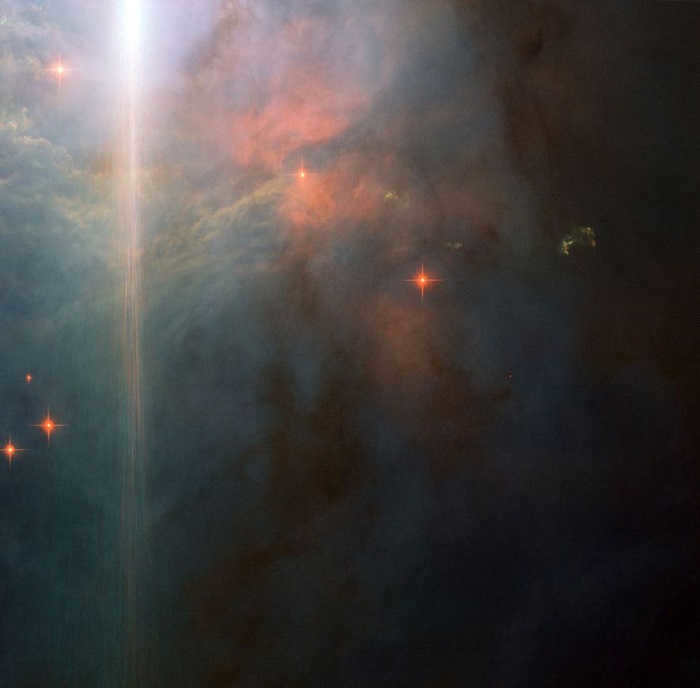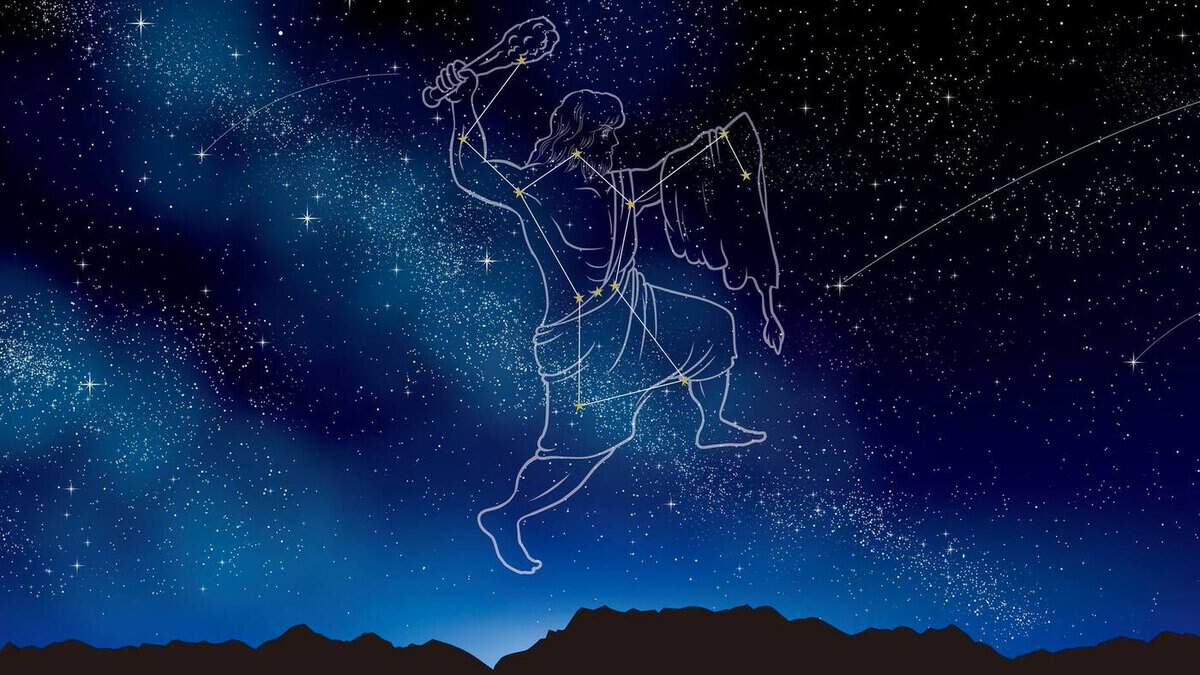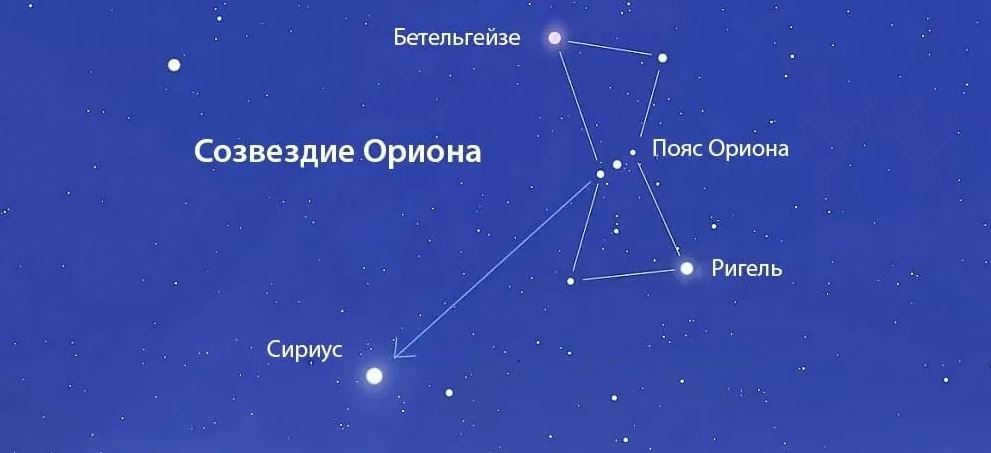
The Orion constellation is easily identifiable in the equatorial sector and stands out in the night sky. Once you spot the constellation, it becomes easy to locate it again later.
Overview
Orion is among the most brilliant constellations visible from Earth. It forms a symmetrical human figure comprising seven stars. In the center, there are three bright objects positioned in a straight line and equidistant from each other. These objects are known as Orion’s Belt.
All of the brightest stars in Orion are young and massive, significantly larger and more powerful than our Sun, with the exception of Betelgeuse. Betelgeuse is a red giant star approaching the end of its life cycle.
Rigel and Betelgeuse, the two brightest stars in the constellation Orion, are nearly equidistant from the belt. They are located on opposite sides of the belt, with Betelgeuse positioned above and to the left, while Rigel is below and to the right. Betelgeuse serves as Orion’s left shoulder, while Rigel represents the hunter’s right foot. Bellatrix is the star that marks Orion’s right shoulder, and Saif indicates the position of his left foot.
Origin of the name
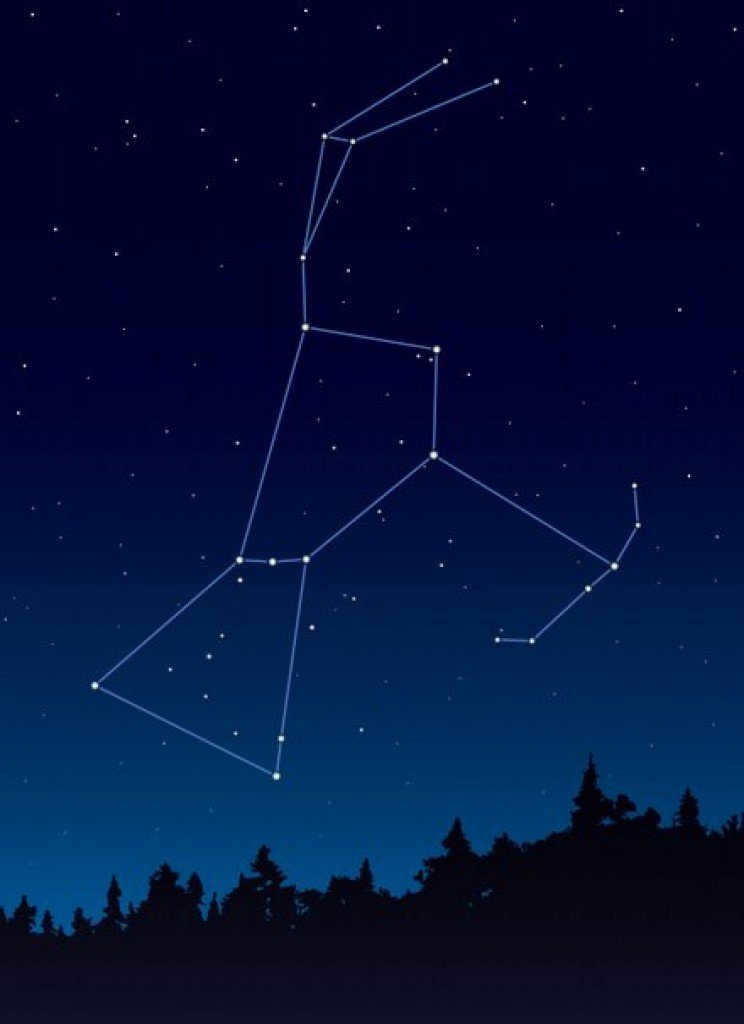
The ancient Egyptians referred to this constellation as the King of the Stars and revered it as Osiris.
In Babylon, it was known as the “Faithful Shepherd of the Heavens”. The Incas called it Chakra or Pata, which means “the grasped one”. According to their belief, the middle star on Orion’s belt represented a criminal, while the two outermost stars symbolized the warriors assigned to capture him. Once captured, the criminal was handed over to the vultures that waited at the top and bottom of the belt.
In ancient Armenia, the constellation was known as Hayk, in honor of the patriarch who was the forefather of the Armenian people. In Russia, the three stars of the belt were referred to as “koromyslo” or “rake”. In Romania, the belt was called “scythe”, while in Estonia it was known as the “stars of the brook”. In the islands of Oceania, it was referred to as a “boat”.
The ancient Greeks perceived the constellation as the hunter Orion, who was believed to be the son of Poseidon and Euryale. After being shot with arrows by the goddess Artemis, Orion’s father placed him in the sky. Another version suggests that Orion met his demise from a scorpion sting and was then immortalized in the sky by Zeus.
Discovering Orion in the Celestial Sphere
Orion, the famous constellation, is a prominent sight in the night sky of the northern hemisphere. Its visibility extends from mid-August to mid-April, with the optimal viewing period being from November to February. During August, Orion can be spotted in the eastern part of the sky before dawn. However, starting from November, this celestial beauty graces the night sky all night long.
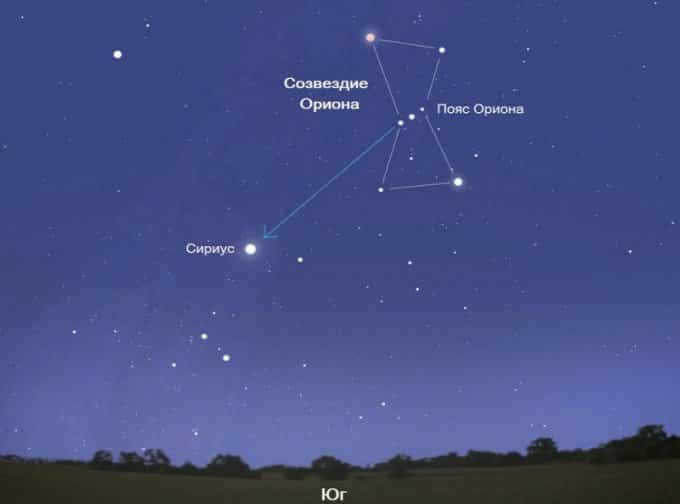
On the stroke of midnight on December 15, the constellation crosses the meridian. At this point, it should be sought in the south, positioned between the zenith and the horizon. In the month of April, Orion becomes almost imperceptible. If you happen to be observing from the equator, the constellation will move from east to west directly over your head, passing through the zenith.
When observed from the southern hemisphere, Orion appears in an inverted position.
Within this constellation, there are a total of 2777 unique objects. Orion is made up of distinct groups of stars, which are identifiable from Earth and have their own individual names:
- The Butterfly or Trapezium, which forms the main outline of the hunter;
- Orion’s Belt, consisting of three bright luminaries;
- Orion’s Sword, made up of two stars;
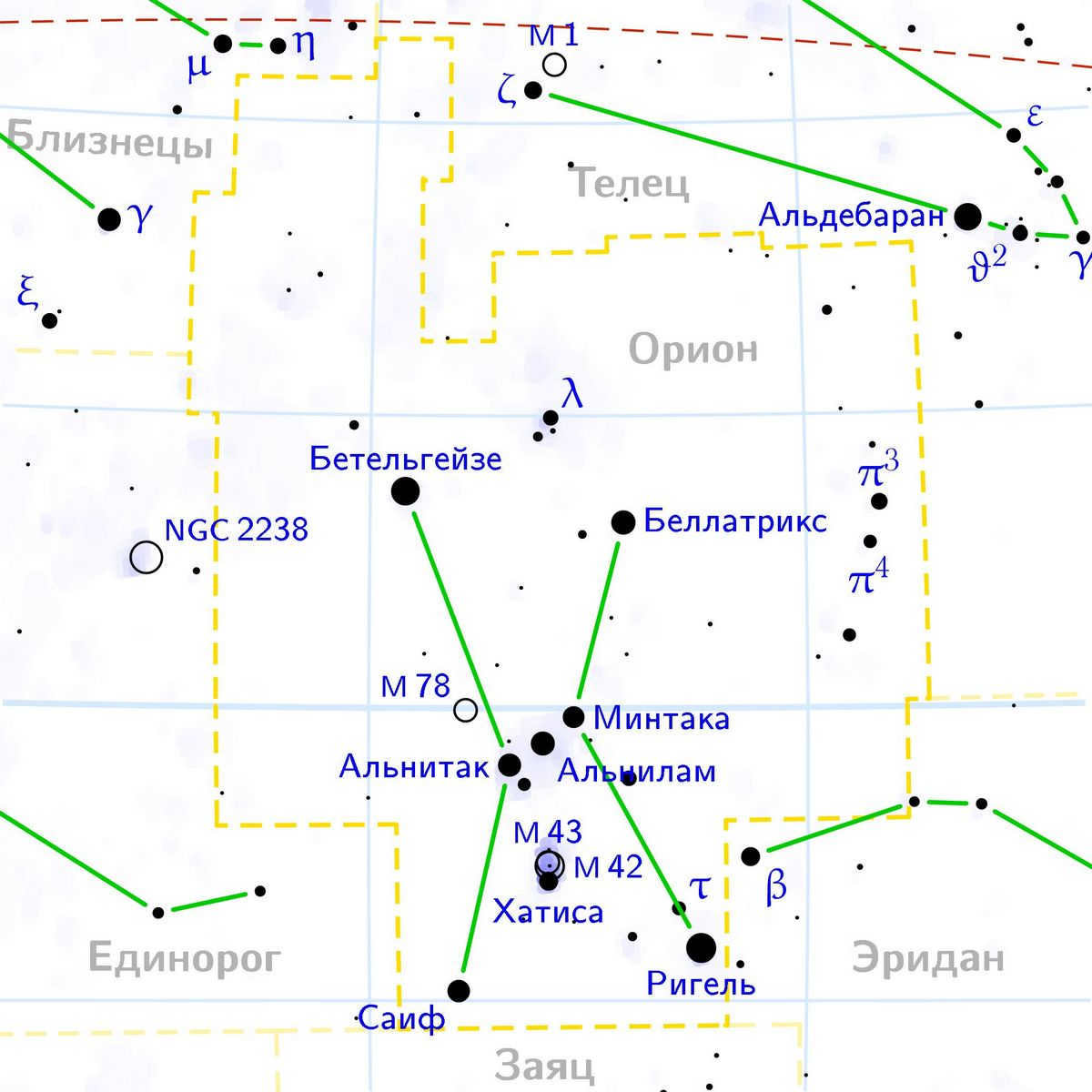 Orion’s Belt
Orion’s Belt
The constellation’s most prominent stars, which have been given Arabic names, are used to highlight the belt: Alnitak (girdle), Alnilam (pearl belt), Mintaka (belt).
When looking at the southeastern end of the belt, it points towards Sirius in the constellation of the Great Dog. On the other hand, the northwestern end points towards Aldebaran in the zodiacal constellation of Taurus.
Alnitak
Alnitak is the third brightest star in the constellation of Orion and is a triple star system. The three stars have a combined magnitude of 1.7, making them a prominent feature in the night sky. Alnitak is located within the Horsehead Nebula, also known as IC434, which adds to its celestial beauty.
Alnilam
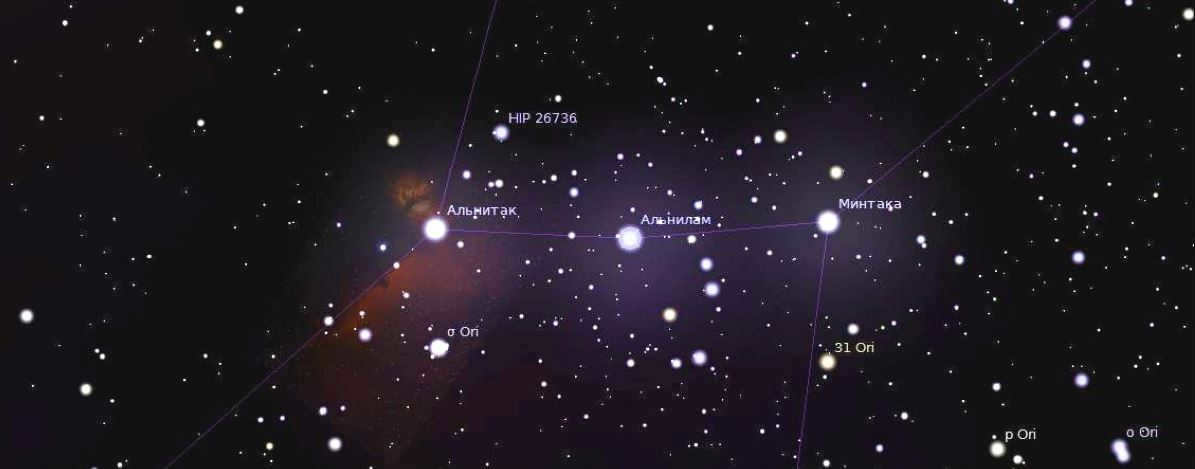
In the constellation of Orion, there is a star positioned in the middle of its belt. This star holds the 29th position in the list of bright stars and is the fourth largest star in the Orion constellation. It is a relatively young star, being only 4 million years old and belongs to the B class, which is known for its powerful supergiants. This star has already depleted its hydrogen fuel in its core and is now burning the remaining hydrogen in a shell outside the core. At its surface, the temperature is approximately 28,800 Kelvin.
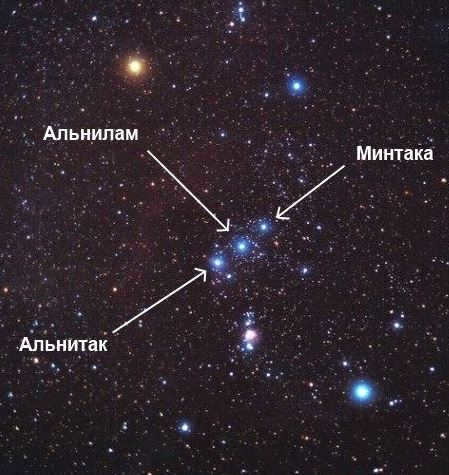
These values were initially computed in the 1970s. As per those estimations, the radius of Alnilam equates to 31.3 times the radius of the Sun. Its mass is approximately 35 times that of the Sun. The total brightness of Alnilam is 600,000 times that of the Sun. The distance of this celestial object is approximately 1,344 light-years away.
However, new data collected from the Heparchus satellite, which extensively observed the star from 1989 to 1993, has challenged the previously held assumptions concerning the properties of Alnilam.
According to the latest calculations obtained in 2015, the distance has been revised to 1977 light-years, while the radius has significantly increased to 42 solar radii, and the mass has surpassed 64 solar masses. Moreover, the brightness has skyrocketed to an astonishing 832,000 times that of the Sun.
If the accuracy of this new data can be verified, Alnilam would become the most luminous star in the entire Milky Way.
Mintaka
Mintaka is the enigmatic third star in the belt, appearing as a solitary star in the night sky. However, it is actually a complex multistar system. The primary star, known as Mintaka A or Orion Delta, is a stunning blue supergiant. Within the constellation, it ranks as the seventh most luminous star and is listed as the 73rd object in the general catalog. While Mintaka is smaller than Alnylam, it is significantly larger than our own Sun, boasting a radius 60 times greater and a mass 25 times more massive. With an estimated surface temperature of around 14,000 Kelvin, Mintaka truly shines in the celestial tapestry.
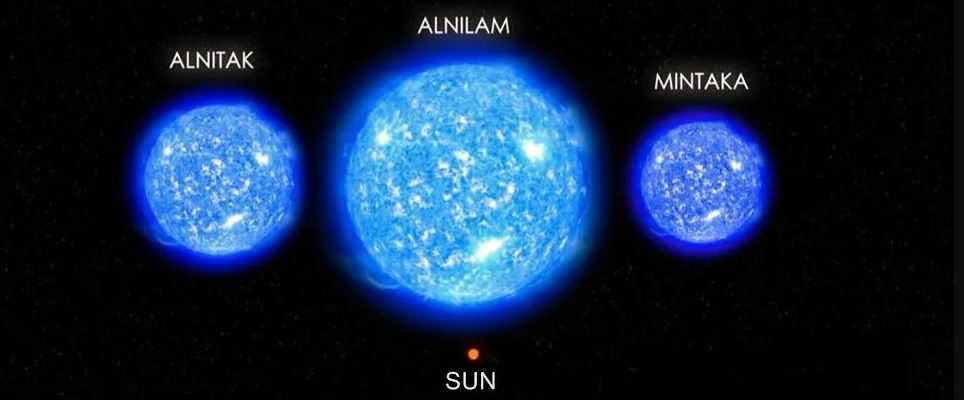
Orion’s Delta Aa2 is situated in closer proximity. This particular star, which has a blue-white appearance, emits light as a result of the reaction between helium and hydrogen taking place in its core. It completes one orbit around Delta A in a span of 6 Earth days. As a result, the brightness index of Mintaka changes periodically due to the overlapping of these celestial objects.
Orion’s Delta Av is the third star in this constellation, and it is classified as a subgiant or a former main-sequence star. During this phase, the star undergoes cooling, increases in size, and its luminosity remains unchanged. It is larger than Aa2, the second star, but much smaller than the first. Delta Av orbits around the main pair for a duration of 400 years.
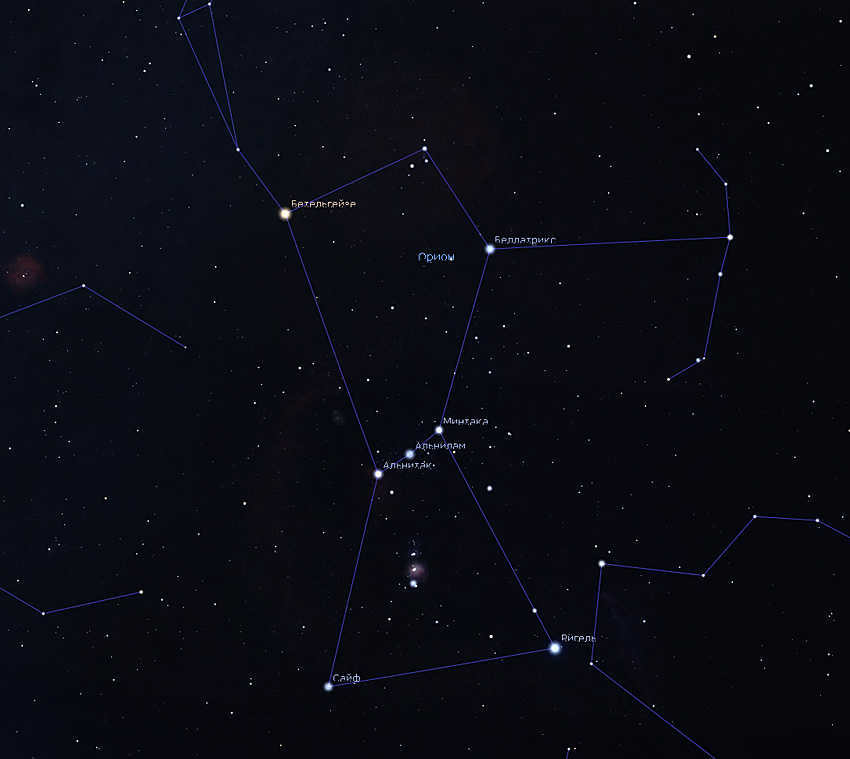
On the right side of these three celestial bodies is Mintaka C, a B-class star that shines in a blue-white color. With a mass 9 times that of the Sun and a radius 5.5 times larger, Mintaka C is a massive star. Its temperature exceeds 15,000K and it exhibits a unique spectrum with prominent lines of helium absorption.
This star possesses a strong magnetic field and a remarkably low rotational velocity, resulting in a stratification of chemicals in its atmosphere and giving rise to an unusual color spectrum effect.
Mintaka C has a companion, which appears dark and is scarcely visible. It completes a rotation every 30 Earth days. The companion star is slightly cooler than our Sun, but has a size that is approximately 0.77 times larger.
Rigel
Rigel, also known as Beta Orionis, is an incredibly luminous blue-white supergiant star located in the Orion constellation. It holds the distinction of being the brightest star in the constellation and is ranked 7th in the general catalog. The name Rigel is derived from the Arabic word for “foot,” reflecting its position as the “left foot” of Orion. With surface temperatures exceeding 12,000 Kelvin, Rigel is considered to be a young and extremely hot star. It is located approximately 860 light years away from Earth and shines between 47,000 to 120,000 times brighter than our Sun.
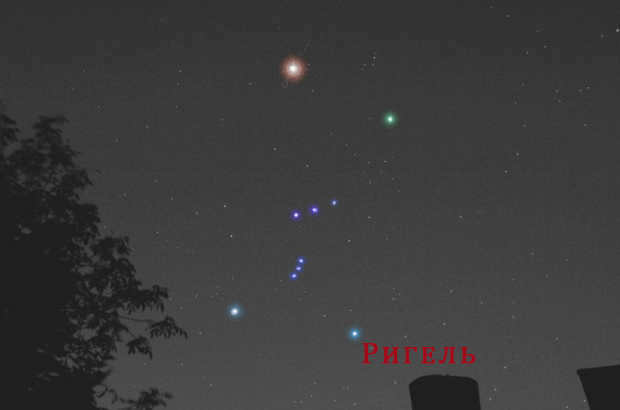
This particular star is a variable star with a magnitude range of 0.03 to 0.3. It experiences changes in magnitude every 21-25 days. Rigel, as it is known, has a radius that is 79 times larger than that of the sun. Additionally, its mass is 21 times greater than our own star.
Recent scientific research has revealed that the distance to this star is actually much greater, approximately 1170 light years. Consequently, its luminosity is now estimated to be 218,000 times that of the Sun.
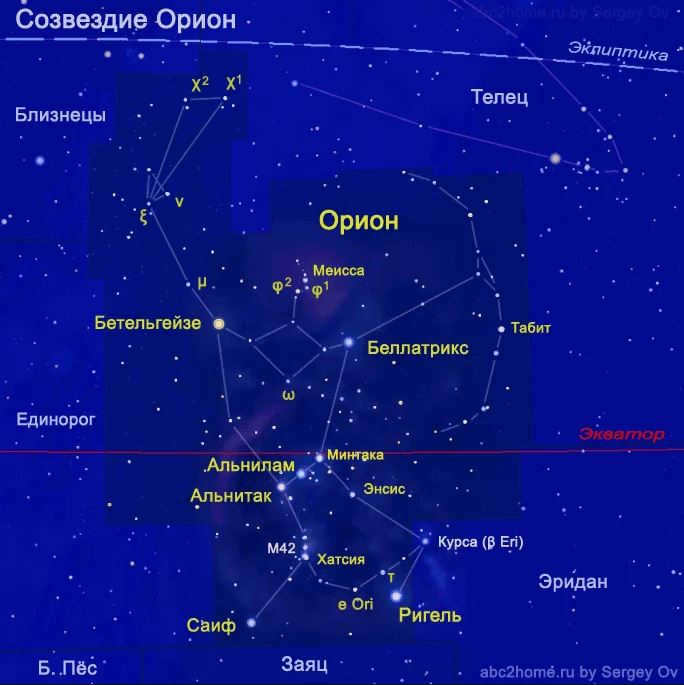
The Rigel star system is composed of four components: Rigel Alpha, Rigel Va, Rigel Bv, and Rigel C. Rigel A is separated from the other three stars and is 400 times brighter than them.
The two stars of Rigel B are in close proximity, 2200 astronomical units away from Alpha. They orbit each other every 9 days. Rigel B and C take approximately 24,000 years to complete their orbit around Alpha. Additionally, they themselves revolve around each other for 63 years.
The surface of blue supergiants undergoes rapid contraction, causing an increase in internal energy radiation and raising the temperature of the star.
Rigel functions as a spectral benchmark for its stellar category. Its spectrum exhibits uncharged helium lines and potent hydrogen absorption lines, along with the dense elements oxygen, magnesium, and calcium.
Different stars in Orion

- The Arabic word for “sword” is Saif. In the Orion constellation, Saif is the sixth brightest star. It is incredibly hot and is located 628 light-years away from Earth. Saif is 57,000 times more luminous than the Sun and emits most of its energy in an invisible range.
- Meissa is a blue giant that is actually made up of two separate objects. In India, Meissa is known as Mrigashira, which means “seeking star.” It has an apparent stellar magnitude of 3.4.
- Betelgeuse is a red giant star that exhibits variations in its luminosity, with an average of 0.7. This massive star is so large that if it were placed in the position of our Sun, it would extend all the way to Jupiter. While Betelgeuse’s diameter is gradually decreasing, its brightness remains constant.
- Bellatrix is the third brightest star in the constellation of Orion and the 26th brightest star in the entire sky. It has a stellar magnitude of 1.65. The distance from Earth to Bellatrix is approximately 243 light-years.
The Enigma of the Star Arrangement
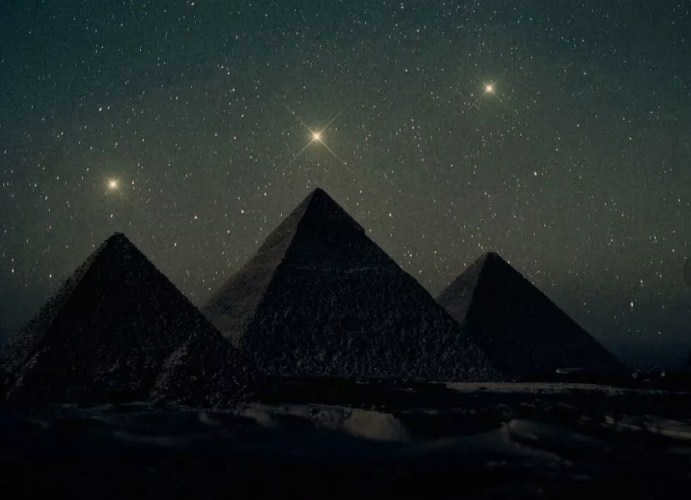
- Orion’s constellation is renowned for its famous nebula, situated beneath the stars that create the belt. It contains regions of massive clusters of recently formed stars, as well as molecular clouds that house billions of newborn stars, emission and reflection nebulae, and relatively young low- and medium-mass stars.
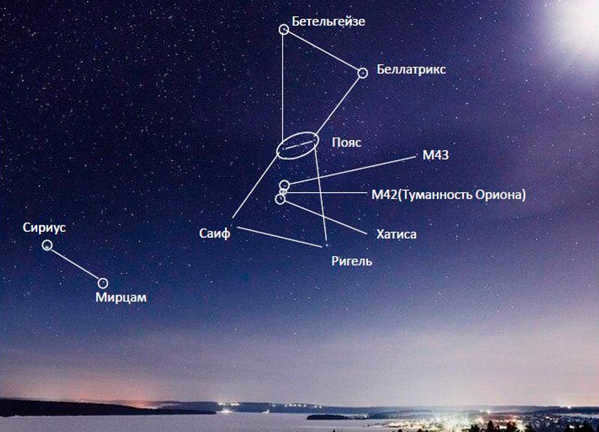
- In 1977, the Voyager 1 and Voyager 2 spacecraft were dispatched to venture beyond the bounds of our solar system in order to investigate far-flung stars. This endeavor, which endures indefinitely, has led Voyager 1 to currently reside a staggering 24 billion kilometers away from our home planet. As a result, it holds the prestigious title of being the most distant artifact ever created by humanity. For context, it would take light a full day to traverse that immense expanse.
Answers to the questions
The speed of light is 299,792,458 meters per second.
Astronomers find the winter sky in the Northern Hemisphere just as fascinating as the summer sky. During this time, there are many bright celestial objects that can be observed. One of the most prominent features in the cold season is the constellation Orion. It covers a large area of the sky and is known for its bright stars and distinctive shape. The Orion belt asterism is one of the key features of this constellation.
Where is it?
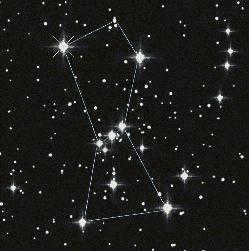
The pattern of stars in the sky is generally easy to identify. However, the most famous feature of the constellation is the belt of Orion. It is often used as a reference point to locate the entire constellation. How can you locate Orion’s belt in the night sky? You need to look towards the southeastern part of the sky. There, on winter and spring evenings, and late at night in the fall, you will find a constellation of impressive size. It is not hard to spot the belt: it consists of three stars that are easily visible and aligned in a straight line. If you extend the line downwards and to the left, you will come across Sirius, which is the brightest star in the night sky. On the opposite side, above and to the right, you will find Aldebaran, the most prominent star in the constellation Taurus.
The constellation Orion is renowned for its belt and several prominent stars. Among these, Rigel and Betelgeuse stand out. Rigel, a blue-white supergiant, can be found to the right of the belt, at the foot of Orion. This star shines brighter than the Sun and ranks among the brightest in our galaxy.
Betelgeuse, on the other hand, is situated on Orion’s shoulder, above and to the left of the belt. Its reddish hue makes it easily recognizable. This supergiant is a variable star and can sometimes outshine Rigel.
Bellatrix, Orion’s second shoulder, is equally captivating. It is the third brightest star in the constellation. Like Rigel, Bellatrix is a blue-white giant.
Three celestial bodies
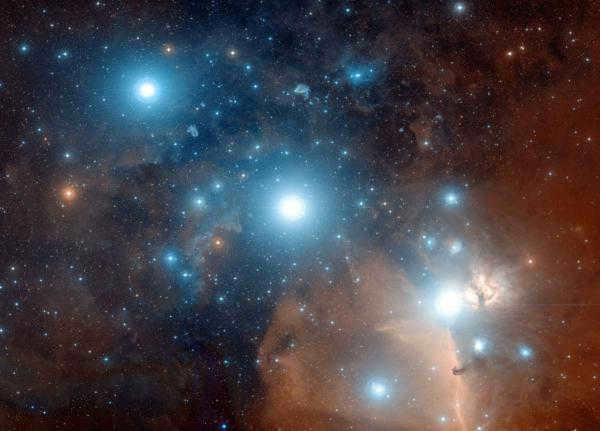
Within the celestial arrangement of the renowned hunter Orion (which originates from ancient Greek mythology), there exist numerous intriguing entities. These include luminous stars, nebulae, and clusters of celestial bodies. However, let us redirect our attention to the belt of Orion. It is comprised of three stars: delta, zeta, and epsilon of the constellation. Furthermore, they are also referred to as Mintaka, Alnitak, and Alnilam respectively in Arabic.
The belt of Orion has been recognized by different civilizations throughout history due to its prominent position in the night sky. It has been connected to various mythological tales and, as a result, the names of the constellation have changed over time. In ancient China, it was referred to as the Scale of Scales or Three Stars. In Scandinavia, prior to the arrival of Christianity, it was known as Freya’s Spinner. The Buryats called it Gurban Bairan, meaning “three standing”. The popularity of this constellation stems from the striking visibility of its stars, which are arranged in a nearly straight line.
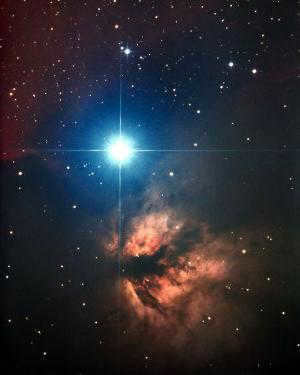
The first star in the asterism is Alnitak, which means “belt”. It is the closest to the Sun among all the stars in the belt, located 817 light-years away from us. Alnitak is actually a triple star system. Zeta Orion A is a blue supergiant with a spectral class of O. It is 28 times more massive and 20 times larger in diameter than the Sun. Its companion, Alnitak B, was first noticed in 1819. It is a giant star that orbits around zeta A with a period of 1500 years.
The third component of this system, Alnitak C, remained unknown to scientists for a long time. It was only discovered in 1998 and is a tenth magnitude star.
Epsilon
Rephrase the text, making it unique and keeping the HTML markup:
Epsilon
Rephrase the content, making it one-of-a-kind while preserving the HTML formatting.
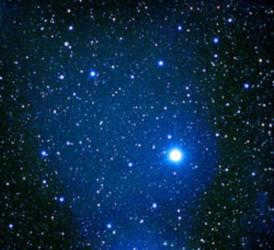
The second star among the constellation of Orion is Alnilam. In Arabic, its name means “string of pearls”. Alnilam is a blue supergiant and shines brighter than many other stars. It is the fourth most luminous star in the Orion constellation, following Rigel, Betelgeuse, and Bellatrix.
Alnilam is used in astronomy for navigation purposes, helping determine the coordinates of objects on Earth and spacecraft orientation. Additionally, the middle star of the Orion belt, with its simple spectrum, provides scientists with valuable insights into the interstellar medium.
Alnilam is gradually approaching the final phase of its life cycle. Scientists predict that within a million years, it will transform into a red supergiant and eventually explode as a supernova.
Delta
Rephrase the text, making it unique while using the English language and preserving the HTML markup:
Delta
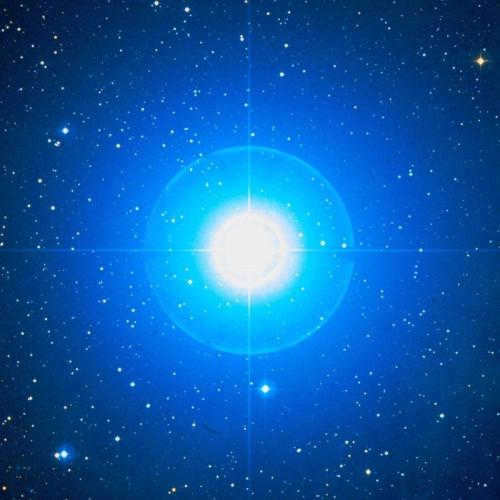
The constellation Orion includes a group of stars known as Orion’s belt. The third star in this belt is called Mintaka, which means “belt” in Arabic. Mintaka is a blue supergiant and is the seventh brightest star in the constellation.
Mintaka is actually a multiple star system. One of its companions is a white star of 7th magnitude, which can be easily seen even with a small telescope. There is also another, less noticeable member of the system located further away. This star has a luminosity of 14th magnitude.
Nebulae
Orion’s belt is surrounded by several captivating entities. The constellation is renowned for the nebulae that reside within it. Positioned just below the belt is M42, an emission nebula that can be easily identified in the night sky even without the aid of a telescope. This particular nebula stands out due to the illumination produced by four youthful stars arranged in the shape of a trapezoid. The Orion Nebula is a hub for various intriguing celestial bodies, including numerous brown dwarfs that have been unearthed in this region.
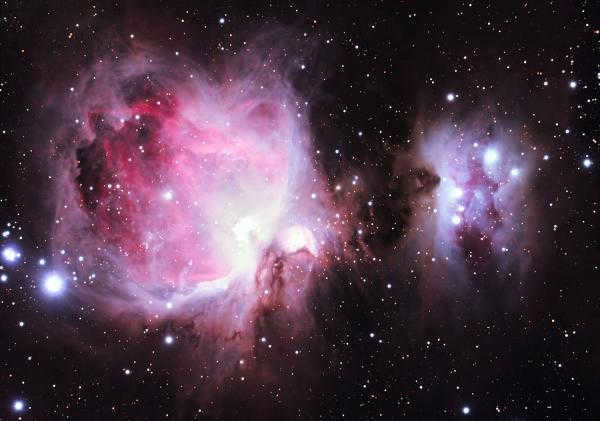
The M43 nebula, located adjacent to M42, is distinguished by a narrow dark band. Within this region, a significant concentration of ionized hydrogen has been identified. It serves as a site for continuous star formation, with new stars constantly being born. The optimal time for observing this phenomenon is during the winter season.
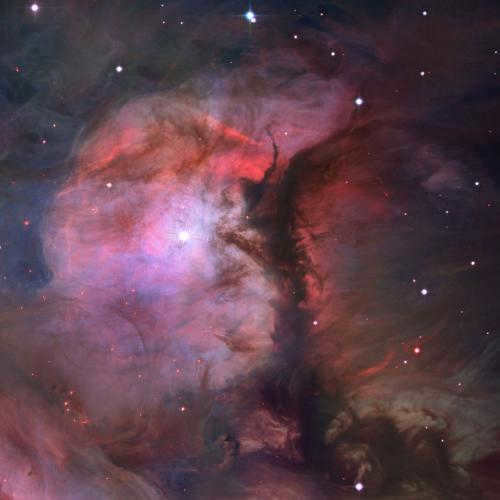
The Flame Nebula can be found next to Alnitak. This stunning celestial object resembles a blazing bonfire or a torch and is located approximately 3000 light years away from the Sun. It is also a region where new stars are continuously formed.
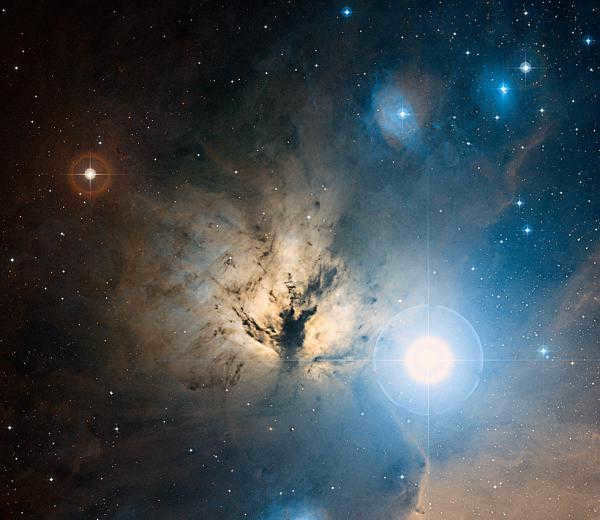
Hence, the belt of Orion represents a region where numerous intriguing entities can be found, captivating both experts and amateur stargazers. This vast constellation continues to allure and captivate observers, just as it did in ancient times. Advanced equipment has brought Orion closer and made it clearer for contemporary individuals. Nevertheless, not everyone is aware of the cosmic expanses contained within this constellation. Nebulae, stars, and other celestial objects that reside within its boundaries are in no rush to reveal their secrets.
The night sky is adorned with numerous stars that glisten above us. These stars are arranged in various constellations, some of which are invisible to the naked eye but are familiar to us through astrology. On the other hand, there are constellations that can be observed from different locations on Earth. One such example is the radiant Orion constellation, which illuminates the European region of Eurasia during the nighttime.
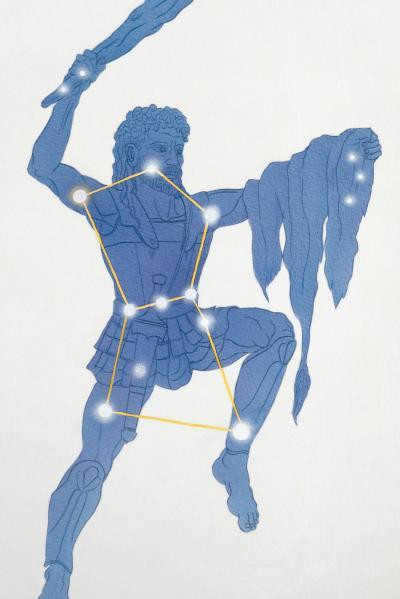
Legends and Myths
Orion is a constellation that has been associated with numerous stories, myths, and legends. Different cultures have interpreted the appearance of this constellation in various ways, resulting in different names being used in different parts of the world where it is visible. The Greeks linked it to their gods, while in Egypt, it was referred to as the King of Stars. In Armenia, it is named after a prominent figure – Hayk, the patriarch and ancestor of Armenians. Some cultures only focused on the three stars in Orion’s belt, naming them Three Sisters, Three Women, Three Men, Three Plows, and so on, without considering the rest of the constellation.
Ancient Greek legend
As per the ancient myths and legends of Greece, Orion was born to Poseidon, the deity of the seas and oceans, and Euryale, one of the Gorgon sisters. Once he reached adulthood, he embarked on a journey and came across a city where he instantly fell in love with the enchanting princess Merope, who happened to be the daughter of King Oinopion. Orion approached the king and requested the hand of his beloved daughter in marriage. However, despite his captivating appearance and renowned reputation as a skilled hunter, his plea was rejected. The king was reluctant to part ways with his cherished daughter. Determined to be with the princess, Orion decided to abduct her forcefully. Upon learning of Orion’s plan, Oinopion captured him and cruelly blinded the handsome young man before casting him ashore.
After receiving guidance from an oracle on how to recover his health, Orion, the young man, had his eyesight restored. His desire for revenge against the king, who had wronged him, led him on a quest to find him. However, his journey took an unexpected turn when he encountered the enchanting Artemis and fell deeply in love with her. The goddess of the hunt reciprocated his feelings, and their relationship seemed destined for happiness. However, Orion’s penchant for bragging about his hunting prowess became a source of trouble.
Hera, the wife of Zeus, held a strong dislike for the handsome young man and decided to intervene. She sent a scorpion to deliver a fatal sting to Orion, poisoning him. Artemis mourned his loss for a long time before ultimately deciding to honor him by placing him among the stars. Orion became a constellation that graced the night sky with its breathtaking beauty, bringing joy to the goddess. In retaliation, Hera positioned the Scorpio constellation on the opposite side of the sky, ensuring that the two constellations would never rise simultaneously.
The myth of the Pleiades
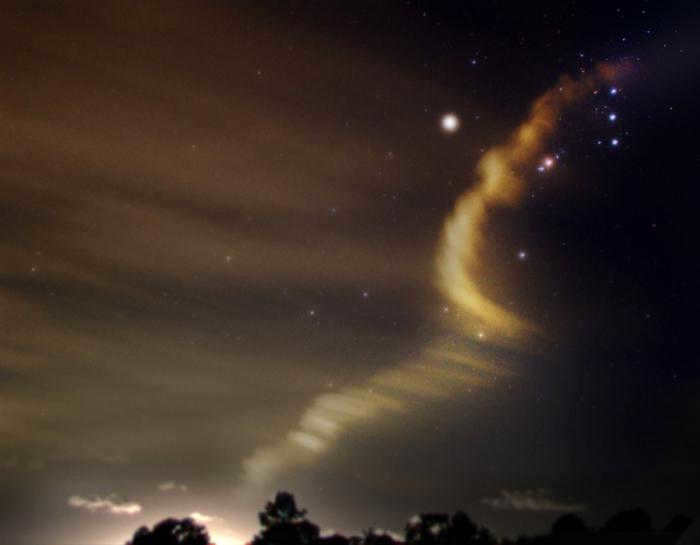
Once upon a time, there were seven sisters living in the celestial realm who enjoyed playing and having a good time. One fateful day, while engrossed in one of their playful activities, they descended too close to the earthly realm and found themselves unable to return home. The sisters felt a deep sense of sadness and ennui in their celestial abode. Thus, they pondered upon a solution to make their way back. They approached a benevolent tree and beseeched it for assistance. They narrated their longing for their heavenly abode, describing the immense joy and radiance they experienced there. Touched by their plight, the tree began to grow taller and taller until its apex reached the heavens.
On Earth, there were seven young men who had developed a deep and intense love for the celestial women. Their hearts yearned for their beloveds, and their gazes were constantly directed towards the heavens above. Moved by their plight, a compassionate tree extended its branches and lifted the young men towards the sky, where they were transformed into the magnificent constellation known as Orion. From that moment on, the seven enchanting women and their devoted partners have remained inseparable. And now, on every clear night, as you cast your eyes upwards towards the sparkling expanse of the night sky, you will behold the ethereal presence of the Orion constellation, shining brightly in close proximity to the Pleiades.
Pyramids of Egypt

Orion is the constellation that serves as a reference point for the construction of the iconic Egyptian pyramids of Giza. It’s difficult to ignore the striking resemblances between these three colossal architectural marvels of Egypt and the stars in Orion’s belt. Furthermore, by examining the celestial bodies that make up this constellation, one can discover additional similarities with the renowned Egyptian architectural complex. Temples, smaller pyramids, and other notable structures are situated at comparable distances from the pyramids, just as the other stars of Orion are positioned relative to the belt.
There is an abundance of coincidences that indicate the remarkable expertise of the ancient civilization responsible for these constructions, surpassing modern technology in many respects. By aligning themselves with the Orion constellation, which astronomers had already mapped out during that era, the ancient Egyptians built structures that precisely mirrored the placement of celestial bodies, as if they were projecting them onto the earth.
Stars in the constellation of Orion
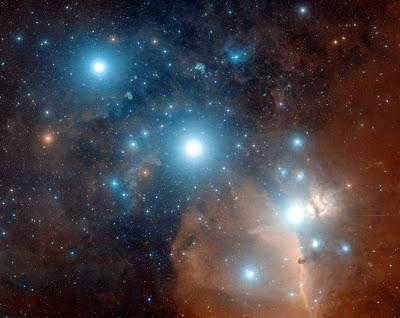
The sky is adorned with a captivating arrangement of vibrant, multicolored stars forming the constellation Orion. Each star possesses its own unique label, size, and significance.
At the forefront of this constellation is the alpha star, known as Betelgeuse, which emits a stunning orange-red hue. Its name, derived from Arabic, translates to “the shoulder (arm) of the giant.” Betelgeuse is classified as an irregular star due to its erratic and pulsating luminosity. With a mass 15 times greater than that of the Sun and a diameter approximately 700 times larger, it truly stands out.
Occupying the beta position within Orion is Rigel, meaning “giant’s foot” in Arabic. This star, the brightest and largest of the constellation, shines with a soft blue radiance. It surpasses the Sun’s luminosity by an astounding 130,000 times. Additionally, Rigel is a variable star, further adding to its allure. In ancient Egyptian culture, this celestial body was revered as the god Osiris.
The star Bellatrix has a diameter three times that of the Sun. It has a blue color and is ranked as the 27th brightest star.
The final star among the brightest ones is known as Saif.
Orion’s belt
The belt of Orion is composed of three stars: Alnitak, Alnilam, and Mintaka. These stars were considered to be the primary ones by many cultures and were given various legends and names.
Mintaka consists of four luminous objects in space that appear as a single entity from Earth.
The next star in the belt is Alnilam. The name translates to “string of pearls” in Arabic. Being a supergiant and located twice as far from the Sun compared to the other stars, it shines just as brightly as the other stars in the Pleiades.
Alnitak also consists of multiple luminous celestial bodies that appear as one from Earth.
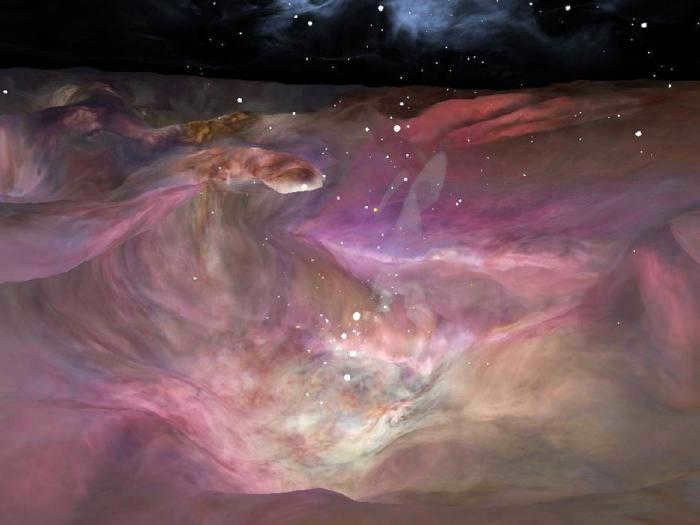
The Orion Nebula
The Orion Nebula can be observed in the location where the stars of the Orion constellation come together to form the “sword” of a warrior or hunter. The emission of light from the ionized plasma creates a cloud that appears very bright from Earth. Its approximate size is 33 light years. The nebula has an arc-shaped form, and its center is known as the Trapezium because of the unique arrangement of stars.
This extraordinary phenomenon can be seen during the winter season, as identifying the Orion constellation is relatively easy at this time. The nebula is visible to the naked eye, but the experience is much more captivating if you have a telescope on hand.
Position of the constellation
The constellation Orion can be found in the northern hemisphere of the celestial sphere. It is considered to be the second most prominent and beautiful constellation after the Big Dipper. To locate the constellation of Orion, one should observe the sky during the autumn or winter months. During this time, it can be easily spotted on the southern side of the sky.
The night sky is filled with numerous astrological signs that can be easily identified. The constellation Orion is often used as a point of reference when searching for the constellations Gemini and Taurus. However, the constellation itself boasts up to 100 visible stars on a clear night.
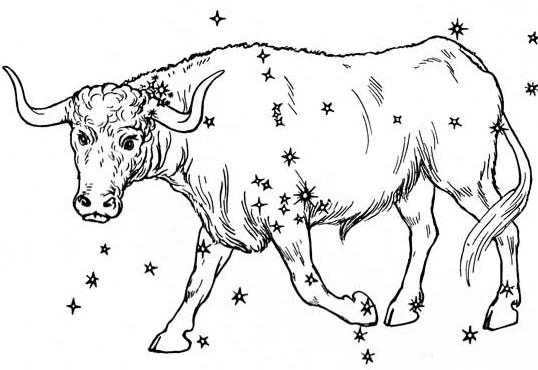
Adjacent constellations
Once you have determined the position of the Orion constellation, you can locate the Great and Little Dog, the Unicorn, the Hare, the Lion, as well as the zodiac signs Gemini and Taurus by its outermost points.
The Gemini constellation is situated to the north of Orion, between the stars Leo and Taurus. The Big Dog and Little Dog appear to be situated behind the hunter. If you imagine a person formed by the stars’ outline, the Hare would be positioned at their feet. Since the Orion constellation is easily identifiable in a clear night sky, you can use it as a reference point to locate other groups of celestial bodies.
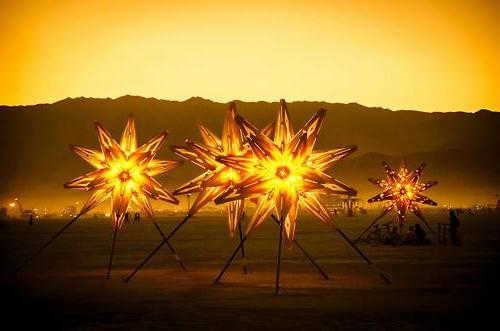
The constellation Orion, which can be observed in planetariums, various books, and textbooks, and is often depicted in paintings and frescoes, has inspired many creative individuals to create their own masterpieces. Artists Don Peterson, Jeremy Bergland, Chad Ingle, and Erich Remasch were among those who were captivated by the mysteries and legends surrounding Orion. They collaborated to create an installation called Starlight, which showcases the seven main stars of Orion. When viewed from above, the installation gives the impression of gazing at the sky.
This unique artwork, known as Starlight, was prominently featured in the annual Burning Man art show. The installation can be found in the Black Rock Desert, Nevada.
Orion is an enigmatic constellation that never fails to captivate with its constant presence in the night sky. For aspiring stargazers, there is no better mentor than this collection of celestial entities. However, before venturing to explore other astronomical wonders, it is imperative to delve deep into the intricacies of this constellation and the captivating narratives and myths intertwined with it. Embark on a journey into the realm of enigmas and uncover the boundless wealth of knowledge surrounding this ancient hunter.
The constellation Orion is an incredibly fascinating region of the sky, boasting a concentrated cluster of bright and captivating objects. Not only are the stars here exceptionally unique, but the nebulae and other celestial bodies are also truly remarkable. Moreover, the nebulae within the Orion constellation serve as active sites for star formation, housing numerous young and hot stars. The area is teeming with dynamic processes, making it an incredibly captivating sight to behold.
Many spectacular features of Orion are visible to the naked eye or through binoculars. However, with the aid of a telescope, one can unlock an array of awe-inspiring images that are nothing short of marvelous.
The Orion constellation in the night sky
Situated along the celestial equator, the Orion constellation’s visibility varies depending on the time of year, making it part of the winter constellations. Covering a significant area of 594 square degrees, it holds the 26th position among all constellations.
Orion, also known as the Hunter in mythology, is often depicted on ancient star charts as a figure holding a wand. This constellation, featuring the iconic belt, can be found adjacent to Taurus (where Orion swings his wand), Gemini, the Unicorn, the Hare, and Eridanus. The Big Dog and Little Dog are close companions of the Hunter.
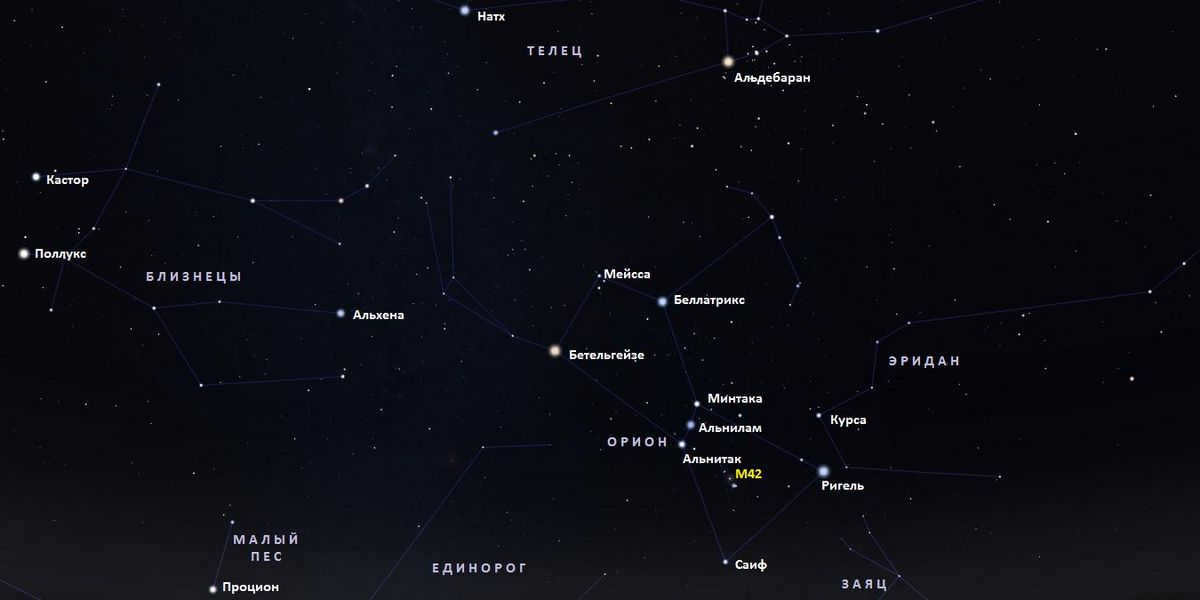
The primary stars of the Orion constellation.
Within the Orion constellation, there are three entities listed in the Messier catalog – M42, M43, and M78. Furthermore, there have been documented exoplanets found in association with seven stars. Additionally, there are numerous prominent stars within this constellation, each possessing their own unique characteristics.
The stars in the Orion constellation are truly breathtaking. This collection of stars is particularly abundant in giants and supergiants. The constant presence of bright hydrogen nebulae allows for the continuous formation of new stars.
Rigel
Let’s begin our exploration with the beta star of Orion, known as Rigel. Despite being labeled as the second brightest star and designated as β, Rigel actually shines the brightest in this constellation. It has a magnitude of 0.3m and belongs to the category of blue supergiants. Rigel emits light that is 130,000 times stronger than our Sun and has a surface temperature of over 12,000 K. In terms of size, Rigel is 74 times larger in diameter than the Sun and 17 times more massive.
Rigel, one of the most powerful stars in our galaxy, holds the potential for a catastrophic event if it were to replace the Sun. In this scenario, the Earth would be swiftly vaporized and its remnants swiftly scattered by the stellar wind.
Aside from its immense power, Rigel is also a variable star with an irregular cycle lasting 22-25 days, which is common among supergiants. Its luminosity fluctuates between 0.03 and 0.3m.
Additionally, Rigel is a multiple star system, specifically a triple star system. The primary component is a blue supergiant known as Rigel A, while the secondary component, Rigel B, consists of a pair of hot blue stars with a combined mass of 2-3 solar masses. The components of Rigel B can be identified using a modest 70-mm telescope, although their separate observation is impossible due to the close proximity of the system, which completes an orbit in just 10 days.
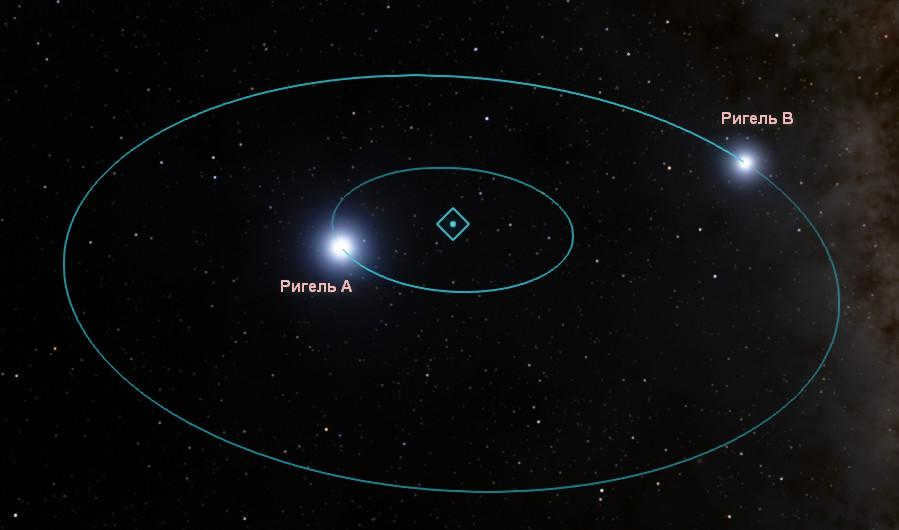
The system of Rigel. Component B is also a binary system.
The estimated distance to Rigel ranges from 700 to 900 light-years, depending on different methods of measurement. Nevertheless, despite this considerable distance, this star remains one of the most luminous in our celestial sphere. Can you fathom its magnificence up there, in close proximity?
Betelgeuse
Rigel may be impressive in terms of size, but it pales in comparison to Betelgeuse, which is Orion’s α star. This particular red supergiant stands out in the night sky due to its distinct red hue. In fact, Betelgeuse is approximately 1000 times larger than our very own Sun and emits a staggering 105,000 times more light.
Similar to other supergiants, Betelgeuse is known to be a semi-regular variable star. It undergoes pulsations, expanding and contracting in size. If we were to replace the Sun with Betelgeuse, its surface would oscillate between the orbits of Mars and Jupiter, with Earth encompassed within this range. As a star expands, its density and temperature decrease, but as it contracts, it becomes denser and brighter.
Imagine how this massive star would appear in the sky at varying distances – 8, 28, and 64 astronomical units. To put it in perspective, we see the Sun from a distance of 1 a.u. These images were captured using the incredible Space Engine program, the most advanced and free simulator of the Universe available today.
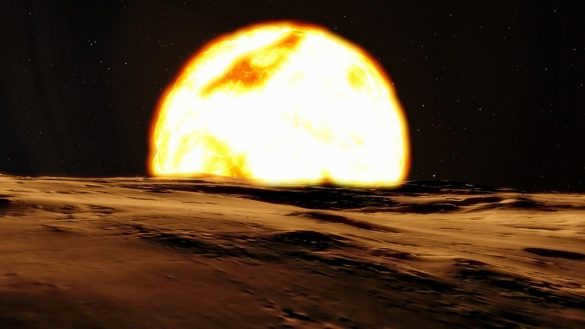
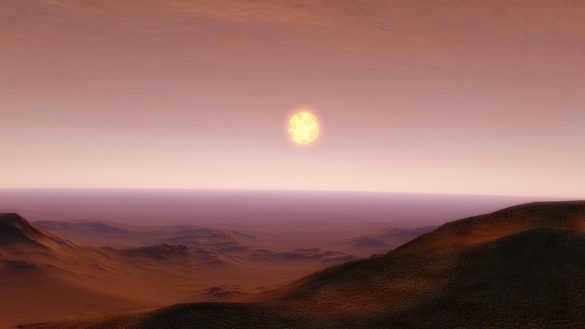
The estimated distance to Betelgeuse is between 500 and 640 light-years, making it slightly closer than Rigel.
Scientists find Betelgeuse particularly fascinating. On June 19, 2017, the ALMA telescope captured an image of the star’s surface, marking the first-ever image of a star’s surface other than the Sun.
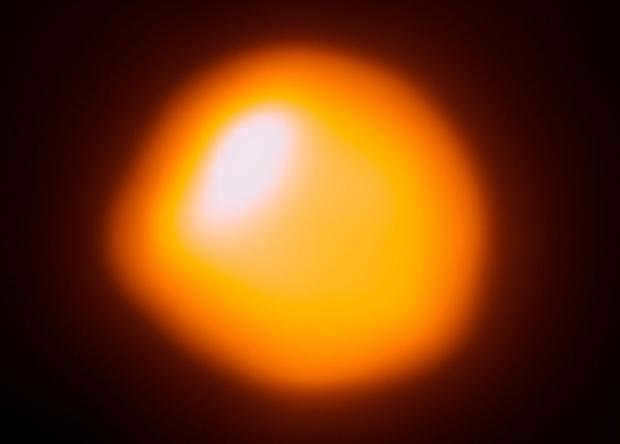
An image of Betelgeuse captured by the ALMA telescope.
There is much speculation about the future of this massive star. In the coming future, Betelgeuse is expected to undergo a supernova explosion, creating a brilliant display that will illuminate our sky for several months, similar in brightness to the Moon. Various predictions have already surfaced regarding the potential impact on life on Earth. However, in reality, the explosion of Betelgeuse is not imminent. It could take years, decades, or even centuries for this event to occur. Furthermore, there is no need for concern as the Earth is separated from Betelgeuse by an immense distance.
Bellatrix
Bellatrix, located in the constellation γ Orion, is the third brightest star in the night sky. While not as luminous as Rigel or Betelgeuse, it still stands out with its distinctive blue hue. When the air is clear, it is easy to spot Bellatrix alongside the red glow of Betelgeuse and the blue brilliance of Rigel. The constellation becomes a breathtaking sight.
With a stellar magnitude of 1.26m, Bellatrix is considered one of the most luminous stars visible from Earth. This blue-white giant outshines even Rigel, boasting a scorching surface temperature of 21,000 K. Despite being only 5.7 times the size of our Sun, it emits a staggering 4,000 times more light.
Similar to other giant stars, Bellatrix is known for its variable nature. Its brightness fluctuates within a range of 6%, adding to its captivating character. Due to its high rotational velocity, matter escapes from its equator at an astonishing speed of 1600 kilometers per second. This makes Bellatrix an eruptive variable star, showcasing its dynamic behavior.
This particular star is relatively young, having formed only around 10 million years ago. However, its lifespan will be relatively short, although it will shine brightly during its existence. In approximately one million years, its resources will be depleted and it will undergo a transformation into a red giant.
Bellatrix, located in the constellation Orion, is situated at a distance of 243 light-years from Earth, making it closer than other prominent stars within the same constellation.
Other notable stars within the constellation Orion
The constellation Orion is abundant in luminous and high-temperature stars. As an example, three stars that form Orion’s belt are of particularly high temperature. Alnitak (ζ) and Mintaka (δ) are classified as rare spectral type O stars, while Alnilam (ε) is a hot giant star that emits light 375,000 times more intense than the Sun. All three stars have surface temperatures exceeding 25,000 K. It is worth noting that Alnilam is currently in the process of losing matter and is encompassed by a molecular gas nebula. Eventually, it will evolve into a red supergiant, surpassing Betelgeuse in brightness, before ultimately exploding in a supernova event.
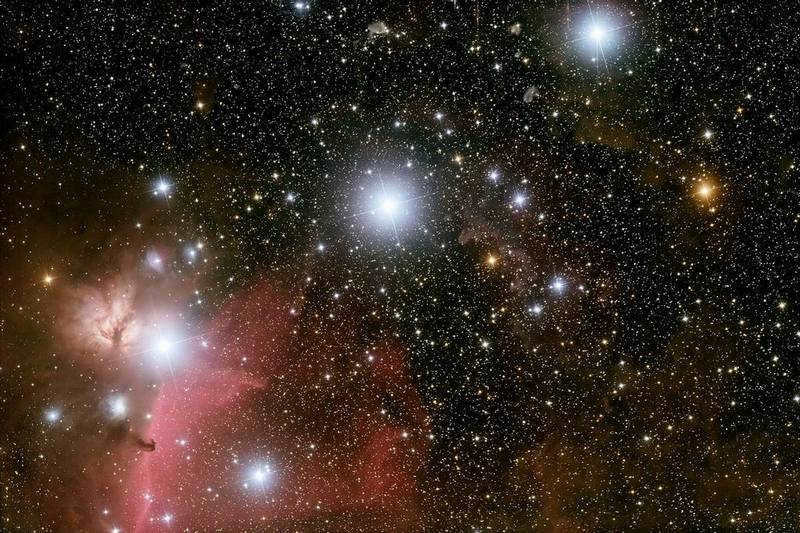
The three stars forming Orion’s Belt are known as Alnitak, Alnilam, and Mintaka.
Mintaka is a type of star known as an eclipsing variable star, meaning its brightness fluctuates as one star passes in front of the other. It is made up of two hot components that orbit each other every 5.63 days. These stars are incredibly luminous, with a brightness 90,000 times greater than that of the Sun. Both stars are also at risk of eventually becoming supernovae. The system is located about 900 light-years away from Earth.
In addition to Mintaka, two other stars in Orion, σ and λ, are also classified as rare spectral class O stars. λ, in particular, is the hottest star in the entire constellation, with a surface temperature of 30,000 K.
Nebulae in the Constellation of Orion
Within the constellation of Orion, there are numerous nebulae of varying types that make up the Orion Cloud. These nebulae are located at a distance of approximately 1500-1600 light years and some are visible to the naked eye.
Orion’s Magnificent Nebula – M42
Just below Orion’s belt, even without the aid of a telescope, one can observe a hazy patch with a magnitude of 4 stars. This is the renowned Orion Nebula, designated as M42. Its images are just as popular as those of the Andromeda Nebula, despite their contrasting characteristics. The Andromeda Nebula is a galaxy consisting of billions of stars, while the Orion Nebula is a cluster of mostly hydrogen gas situated within our own Galaxy, which is illuminated by nearby stars. This celestial object in the winter sky is the focal point for all astronomy enthusiasts, who eagerly direct their telescopes or binoculars towards it.
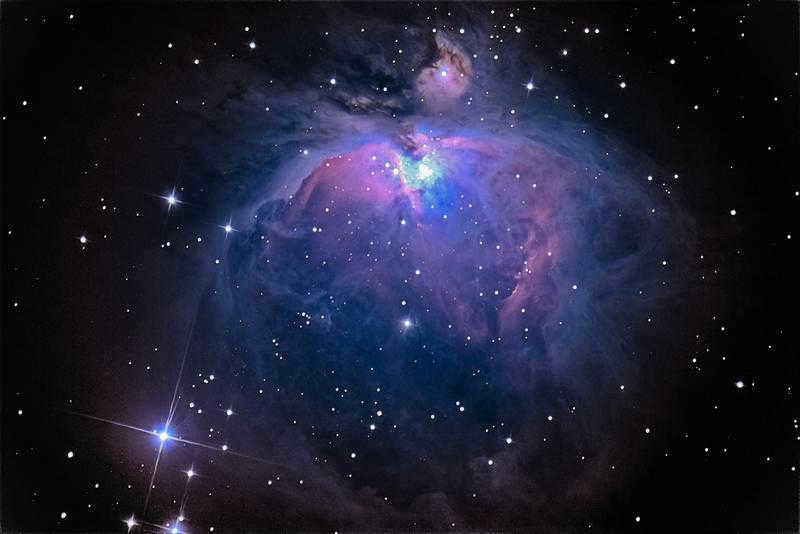
The M42 nebula is a spectacular sight in the night sky.
This celestial object covers an expanse in the heavens that is four times larger than the full Moon, although this is not evident to the naked eye. The Orion Nebula is located at a distance of 1,344 light-years and measures 33 light-years across.
Despite its apparent density, the gas in the Orion Nebula is incredibly sparse. In fact, one milligram of the nebula would occupy a volume of 100 cubic kilometers. To put this into perspective, the best laboratory-created vacuum is millions of times denser than this nebula. However, the sheer size of the Orion Nebula is mind-boggling. If all the hydrogen within it were gathered together, it could form a thousand stars similar to our Sun, or even 300 million Earth-sized planets!
The luminescent effect in the Orion Nebula is caused by the light emitted by stars that are either immersed in the nebula or located nearby.
M43 – The De Meran Nebula
Discovered by Frenchman Jean-Jacques de Meran in 1731, the De Meran Nebula is named in his honor. It is situated just above and to the left of the Great Orion Nebula, and is actually a part of it. Even a 100mm telescope can provide a view of this nebula, and the black gap between the two nebulae is clearly visible. This gap is simply a cluster of interstellar dust in the foreground, so the separation of these nebulae is purely a visual phenomenon.
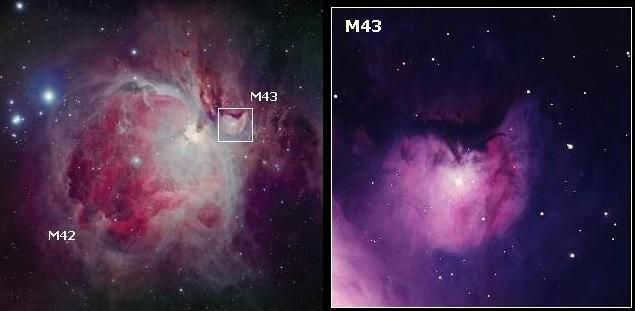
The M43 nebula can be found right next to the Great Orion Nebula. What sets this image apart is that it is inverted.
At a distance of 1600 light years away from us, this nebula has a star magnitude of 9.
Nebula M78
This particular nebula is also known as NGC2068, and it can be seen just above and to the left of Orion’s belt. It shines with a brightness of 8.3m and is illuminated by three stars with a magnitude of 10. When using a small telescope, it is quite easy to spot M78. Inside this nebula, you can find approximately 45 Taurus-type variable stars, which are young stars that are still in the process of forming.
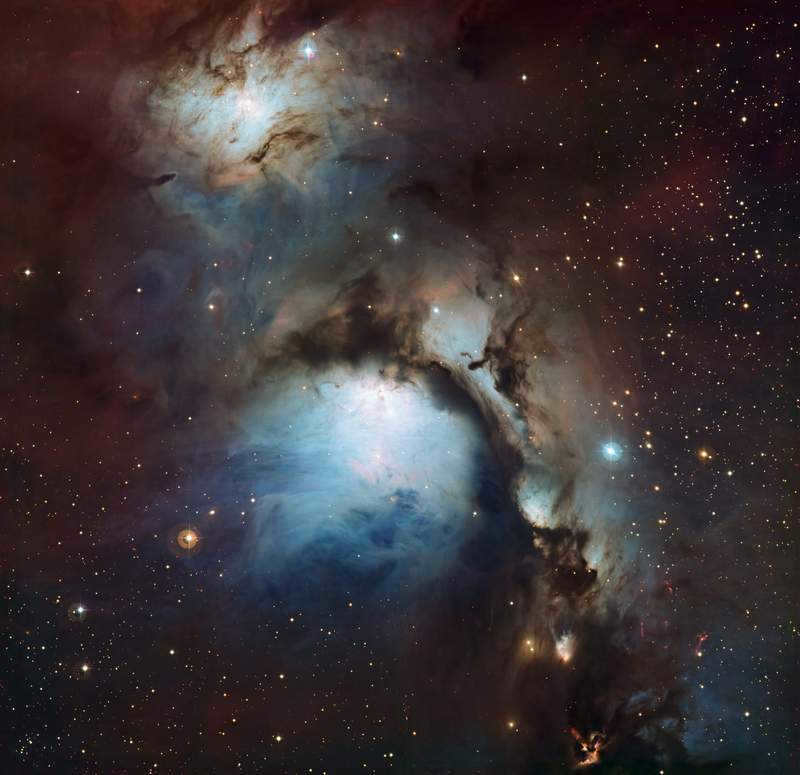
The Nebula Resembling a Horse’s Head
Designated as IC 434 or Barnard 33, this nebula consists of the darker portion of the bright IC 434 nebula. Its name is derived from its resemblance to the head of a horse and is composed of dust clouds and gases set against a brilliantly glowing hydrogen nebula. It is renowned as one of the most breathtaking nebulae, with its image often featured in various sources.
Situated below Alnitak, the first star in Orion’s belt, the nebula was first discovered by American astronomer William Fleming in 1888. It is located at a distance of 1,500 light years from Earth.
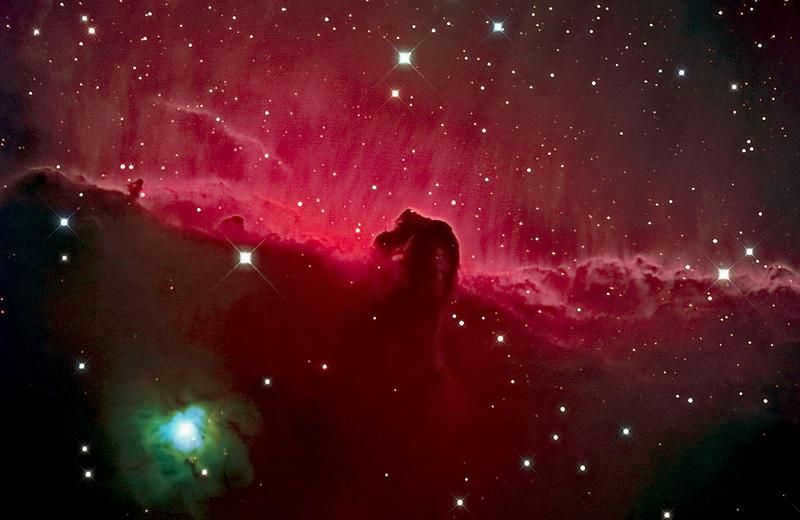
The Horsehead Nebula, a dark gas-dust nebula, is known for its distinctive appearance.
NGC 2024: The Flame Nebula
NGC 2024, commonly known as the Flame Nebula, can be found in close proximity to Alnitak, the brightest star in the Orion constellation belt. This remarkable nebula is currently experiencing a period of active star formation and is bathed in the radiant glow emitted by the youthful, high-temperature stars that reside within its boundaries and in its immediate vicinity.
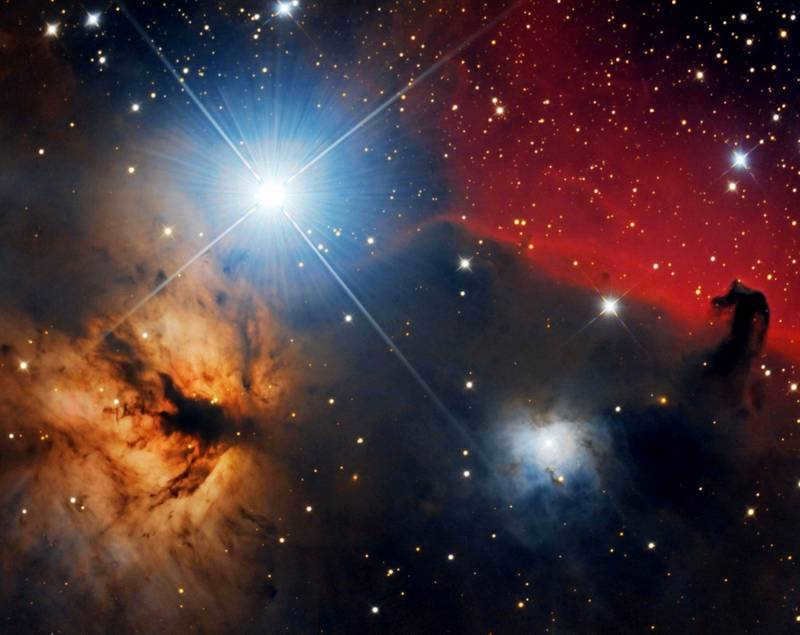
Alnitak stands out as the most brilliant star in the constellation. To the lower left, you can find the Flame Nebula, while the Horsehead Nebula can be seen on the right side.
Within the constellation of Orion, there exists a multitude of distinct nebulae, primarily concentrated around the Great Orion Nebula and the stars comprising Orion’s belt. The entirety of this celestial array can easily be located utilizing the planetarium software known as Stellarium. Presently, all of these nebulae are actively engaged in the process of star formation, thereby accounting for the abundance of youthful, luminous, and intensely hot stars within the Orion constellation. In particular, numerous colossal stars are poised to eventually undergo supernova explosions, thereby fostering the birth of additional nebulae. This notion is further substantiated by the presence of numerous unstable stars of the T Taurus classification within each Orion nebula. These stars, whose internal mechanisms have yet to stabilize, boast an age of no more than a few million years, signaling the nascent stage of their life cycle.
This star formation is part of the winter constellation, so it can be observed from mid-autumn to spring in the northern hemisphere. As early as mid-October, it can be seen rising in the east with the onset of night, and with patience, it can be fully observed.
During the winter months, the Orion constellation can be seen high in the sky shortly after sunset. The neighboring constellation of Canis Major, with its bright star Sirius, is also clearly visible. The optimal time for observing Orion when it is at its highest point above the horizon is in January.
As spring arrives, the Orion constellation gradually shifts closer to the west and becomes lower in the sky. In mid-spring, the upper part of the constellation, including the star Betelgeuse, can still be seen before eventually disappearing.
During the summer months, Orion is not visible in the northern hemisphere. It can only be observed in the southern hemisphere during this time.

Orion is a well-known constellation situated on the celestial equator. It has been recognized since ancient times and is often referred to as the Hunter due to its depiction of the mythological figure Orion. In various depictions, Orion is shown standing in front of Taurus or in pursuit of a Hare with his two dogs, Big Dog and Little Dog.
Within the constellation of Orion, there are two of the ten brightest stars: Rigel and Betelgeuse. Additionally, notable features include the Orion Nebula (M42), the De Meran Nebula (M43), and the Horsehead Nebula. The Trapezium cluster and the well-known asterism, Orion’s Belt, can also be found here.
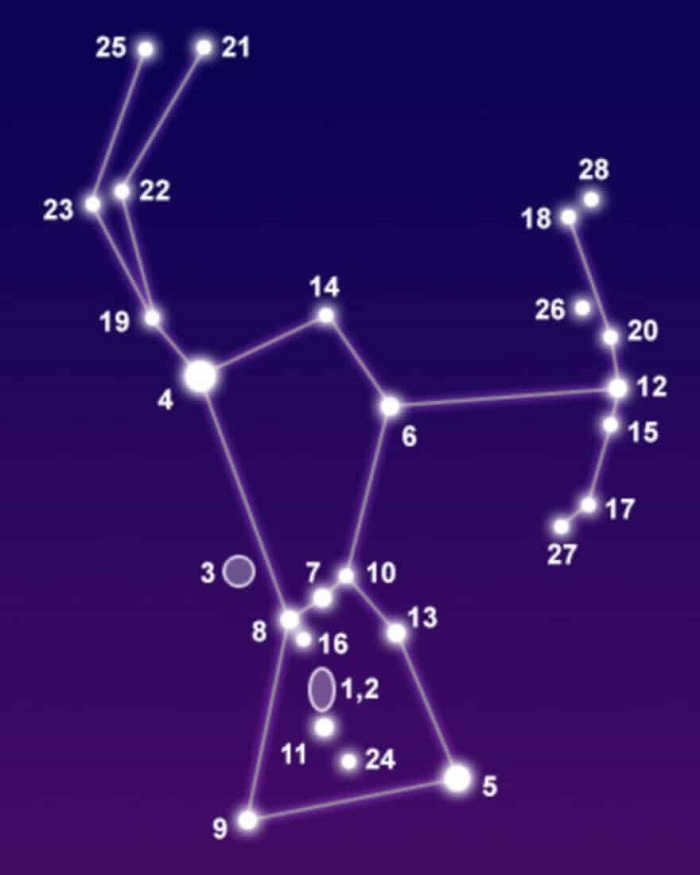
Facts, location, and map
The constellation Orion is ranked 26th in size, covering an area of 594 square degrees. It occupies the first quadrant in the northern hemisphere (NQ1) and can be observed at latitudes ranging from +85° to -75°. Orion is bordered by the constellations Eridanus, Gemini, Unicorn, Taurus, and Hare.
| Orion | |
| Ori | |
| Orion | |
| 4 hours 37 minutes to 6 hours 18 minutes | |
| -11° to +22° 50' | |
| 594 square degrees (26th place) | |
| Rigel (β Ori) – 0.18 m Betelgeuse (α Ori) – 0.2-1.2 m Bellatrix (γ Ori) – 1.64 m Alnilam (ε Ori) – 1.69 m Alnitak (ζ Ori) – 1.74 m Saif (κ Ori) – 2.07 m Mintaka (δ Ori) – 2.25 m Hatice (ι Ori) – 2.75 m | |
| OrionidsHi Orionids | |
| GeminiTaurusEridan the HareThe Unicorn | |
| This constellation can be seen at latitudes ranging from +79° to -67°. The ideal time to observe it is in January. | |
The constellation Orion is home to several astronomical objects, including three Messier objects: Messier 42 (M42, NGC 1976), Messier 43 (M43, NGC 1982), and Messier 78 (M78, NGC 2068). Additionally, there are seven stars within Orion that have planets orbiting them. Among these stars, Rigel shines the brightest with a visual magnitude of 0.18, making it the sixth brightest star overall. Betelgeuse, on the other hand, holds the position of the second brightest star in Orion with a visual magnitude of 0.43, placing it at the eighth position on the list. Orion is also home to two meteor streams: the Orionids, which occur on October 21, and the Chi Orionids. As part of the Orion group, Orion is connected to other constellations such as Hare, Unicorn, Big Dog, and Little Dog. Take a look at a star map to see a diagram of the constellation Orion.
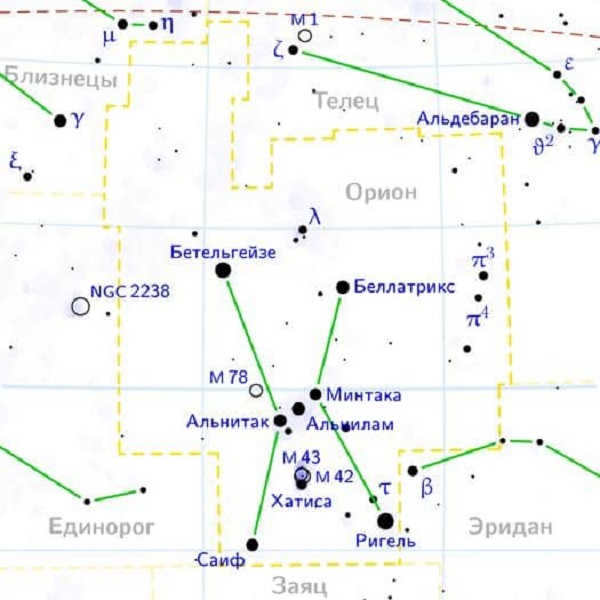
Legend
The constellation Orion has a fascinating history and an intriguing name. Orion, the legendary hunter, was renowned for his extraordinary beauty. He was the son of Poseidon and Euryale, who was the daughter of Minos. In the epic poem The Odyssey, Homer described Orion as a towering and invincible figure. According to one mythological account, Orion became infatuated with the Pleiades, a group of seven sisters who were the daughters of Atlas and Pleione. He relentlessly pursued them, but Zeus intervened and hid the Pleiades in the sky within the constellation Taurus. However, if one looks closely, it is still possible to observe Orion persistently trailing the Pleiades.
In a different legend, Orion was infatuated with Merope, the daughter of King Enopolis, but she did not feel the same way. One day, in a drunken state, Orion tried to forcefully win her over. This angered the king, who blinded him and banished him from his kingdom. However, Hephaestus, the god of fire and craftsmanship, took pity on Orion and sent one of his assistants to restore his sight. Eventually, Orion encountered an Oracle who informed him that his vision would be restored if he reached the eastern horizon by sunrise. Against all odds, Orion accomplished this feat and his sight was miraculously restored.
The ancient Sumerians were also familiar with the myth of Orion, which they associated with the tale of Gilgamesh. In their version, Orion was a hero who was compelled to battle the celestial bull, known as Taurus or GUD AN-NA. The Sumerians referred to Orion as URU AN-NA, meaning “the light of the heavens.”
While depicted in maps as battling a bull, there is no mythological tale to support this representation. Ptolemy described him as a hero armed with a club and wearing a lion’s skin, attributes typically associated with Heracles. However, due to the constellation’s lack of prominence and Hercules’ well-known encounter with a bull, a link is occasionally made between the two.
The scorpion is featured in nearly all accounts of Orion’s death. In one version, Orion boasted to Artemis and her mother Leto that he was capable of defeating any creature on Earth. In response, Leto sent a scorpion to kill him with its deadly venom. Alternatively, Orion attempted to win Artemis’ affections, prompting her to send a scorpion to kill him as well. In another variation of the tale, Orion died from the scorpion’s poison while trying to protect Leto. Regardless of the version, the outcome remains the same – a fatal sting from a scorpion. Both Orion and the scorpion ascended to the heavens, with Orion disappearing over the western horizon as if fleeing from his killer.
However, there exists an alternate story. Artemis fell in love with a hunter, but Apollo, unwilling to let her abandon her chastity, presented her with a bow and arrow and instructed her to shoot at a small target. Unaware that the target was Orion, she inadvertently killed the man she desired.
The subordinates of pharaohs regarded them as divine beings, which is why the majority of the pyramids (at Giza) were constructed to showcase the celestial pattern. The Aztecs, on the other hand, interpreted the emergence of stars in the sky as a sign of the commencement of the New Fire ceremony. This ritual was crucial as it postponed the predicted doomsday.
In Hungarian folklore, the figure associated with this concept was Nimrod, the skilled hunter and father of the twins Hunor and Magor. The Scandinavians identified this celestial entity as the goddess Freya, whereas in China, it was known as Shen (the hunter and warrior). In the second millennium BC, the Hittites fashioned a legend about the goddess Anat, who fell in love with a hunter. When he refused to lend her his bow, she dispatched a man to steal it. However, he was unsuccessful and accidentally dropped it into the sea. Hence, the constellation disappears below the horizon for two months during the spring season.
The primary celestial bodies
Discover the magnificent stars within the constellation of Orion through in-depth explanations, images, and attributes.
Rigel (Beta Orionis) is a massive blue supergiant (B8lab) situated 772.51 light-years distant. It outshines the Sun by a factor of 85,000 and possesses a mass 17 times greater. This star exhibits irregular and faint variations in brightness, ranging from 0.03 to 0.3 magnitude over a span of 22-25 days.
With an apparent visual magnitude of 0.18 (the brightest in its constellation and the sixth brightest in the sky), Rigel is a triple star system. In 1831, F.G. Struve characterized it as a visual binary enclosed by a gaseous envelope.
Rigel A is 500 times more luminous than Rigel B, which itself functions as a spectroscopic binary star with a magnitude of 6.7. It consists of a pair of main-sequence stars (B9V) with an orbital period of 9.8 days.
This star is surrounded by adjacent dust clouds that it illuminates. One of these dust clouds is IC 2118 (also known as the Witch’s Head Nebula), a faint reflecting nebula located 2.5 degrees northwest of Rigel in the constellation Eridanus.
Rigel A belongs to the Taurus-Orion R1 association. Some experts suggest that it would fit seamlessly into Orion’s OB1 Association, but the star is too close to us. It is approximately 10 million years old and will eventually evolve into a red supergiant resembling Betelgeuse.
The name originates from the Arabic expression Riǧl Ǧawza al-Yusra, meaning “left foot.” Rigel denotes the left foot of Orion. It was also known as il al-Shabbar in Arabic, signifying “the foot of the great one.”
Betelgeuse (Alpha Orion, 58 Orion) is a red supergiant (M2lab) with a visual magnitude of 0.42 (the second brightest in the constellation) and a distance of 643 light-years. Its absolute magnitude is -6.05.
Recent discoveries indicate that the star emits more light than 100,000 suns, surpassing the brightness of most stars in its class. Consequently, we can conclude that the classification is outdated.
Its apparent diameter ranges between 0.043 and 0.056 arc seconds. Achieving greater precision is challenging due to the star’s periodic shape alterations caused by its massive loss of mass.
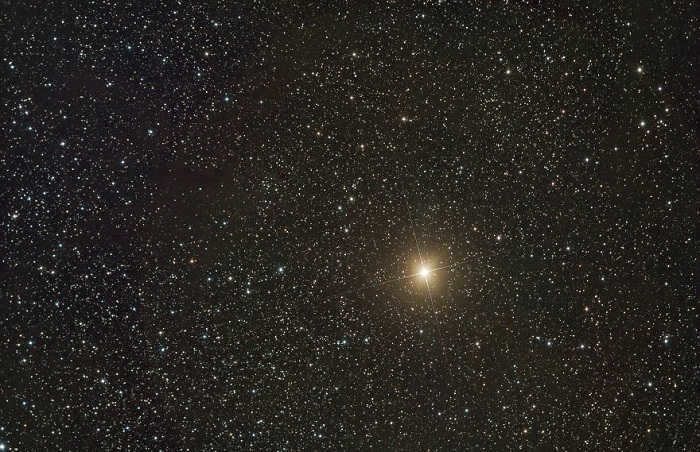
The star is a semi-regular variable, with its apparent visual magnitude ranging from 0.2 to 1.2, sometimes even outshining Rigel. John Herschel first observed it in 1836. Despite being only 10 million years old, it is not yet a red supergiant due to its rapid evolution caused by its massive size. However, it is expected to explode as a supernova within the next million years. During this event, it will be visible even during the day, shining brighter than the Moon and becoming the brightest supernova in history.
In addition to its astronomical significance, the star is also part of two asterisms: the Winter Triangle, which includes Sirius and Procyon, and the Winter Hexagon, which includes Aldebaran, Capella, Pollux, Castor, Sirius, and Procyon.
The name “Betelgeuse” is derived from the Arabic phrase “Yad al-Jawzah”, meaning “the hands of Orion”. When translated into medieval Latin, the phrase became “Betleguez”. However, a mistake was made in the translation, where the first Arabic letter was misinterpreted as a “b”. As a result, the name “Bait al-Jauzā'” was coined during the Renaissance, meaning “Orion’s house”. It is fascinating to think that a single error in translation led to the evolution of the modern name for this star.
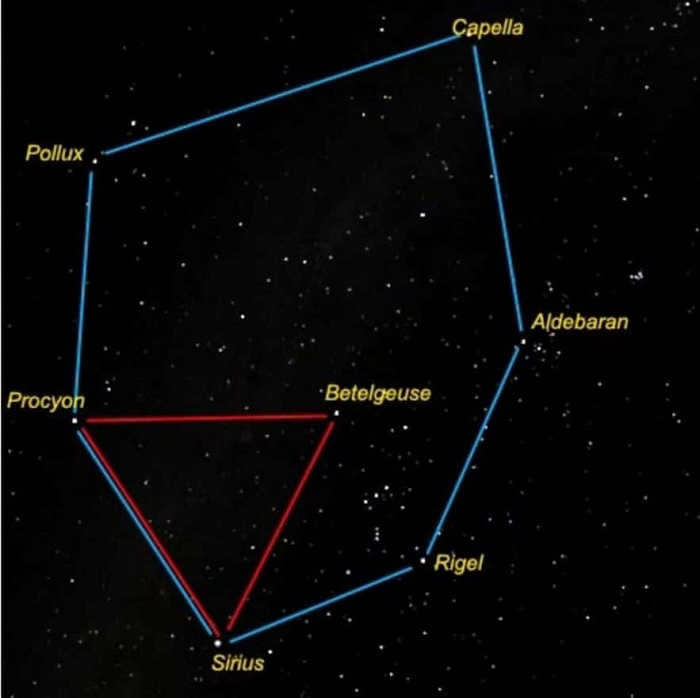
Bellatrix (Gamma Orionis, 24 Orionis) is a massive, hot, luminous blue-white giant star (B2 III) that has a range in brightness from 1.59 to 1.64 and is located approximately 240 light-years away. It is one of the hottest stars that can be seen with the naked eye. It emits 6400 times more sunlight and has a mass that is 8-9 times that of our Sun. In a few million years, it will evolve into an orange giant and eventually become a massive white dwarf.
It is sometimes referred to as the Amazon Star. It is the third brightest star in the constellation of Orion and the twenty-seventh brightest star in the entire sky. Its name is derived from the Latin term for “warrior woman.”
Orion’s Belt is composed of three stars: Mintaka (Delta Orionis), Alnilam (Epsilon Orionis), and Alnitak (Zeta Orionis).
Orion’s Belt, consisting of three luminous stars – Mintaka (Delta), Alnilam (Epsilon), and Alnitak (Zeta), is widely recognized as one of the most renowned asterisms in the celestial sphere.
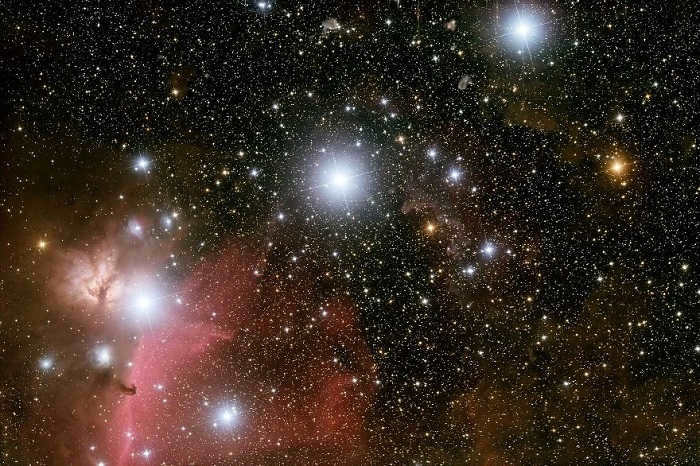
Mintaka (Orion Delta) is a variable binary star system. It consists of a B-type giant star and an O-type hot star, which orbit each other every 5.63 days. During their orbital motion, they alternate in brightness, with a decrease of 0.2 magnitudes. Located 52″ away from this double star system is another star with a magnitude of 7, as well as a faint star with a magnitude of 14.
This binary star system is located 900 light years away. The main stars are incredibly bright, being 90000 times brighter than the Sun, and they have a combined mass that is more than 20 times that of the Sun. Eventually, both stars will undergo supernova explosions at the end of their lives. In terms of brightness, the apparent magnitudes of the components are 2.23 (3.2/3.3), 6.85, and 14.0.
Alnilam (Orion Epsilon, 46 Orion) is a supergiant star that shines brightly in the night sky. With an apparent magnitude of 1.70, it is one of the brightest stars in the constellation and ranks 30th overall. Located approximately 1300 light-years away, Alnilam is a hot, blue star that emits an impressive 375,000 times the luminosity of our Sun.
Situated at the center of the Orion’s belt, Alnilam is surrounded by the NGC 1990 nebula, which is a cloud of gas and dust. The star’s stellar wind reaches incredible speeds of 2,000 kilometers per second. At 4 million years old, Alnilam is relatively young. However, it is currently losing mass, indicating that its internal hydrogen fusion is nearing its end.
In the future, Alnilam will undergo a dramatic transformation. It will evolve into a red supergiant, surpassing the brightness of Betelgeuse, another well-known star in the sky. Eventually, Alnilam will explode as a supernova, releasing an enormous amount of energy. The star’s name, derived from the Arabic word "an-niżām," translates to "string of pearls," a fitting description for such a magnificent celestial object.
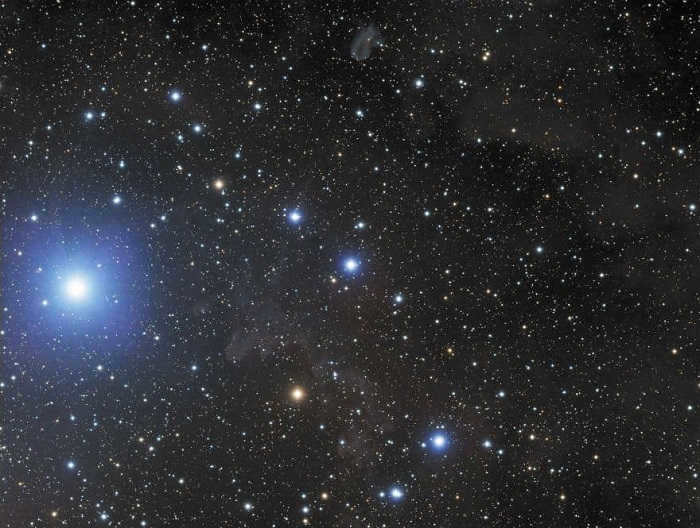
Alnitak (also known as Zeta Orionis or 50 Orion) is a star system that consists of multiple stars. It has an apparent magnitude of 1.72 and is located at a distance of 700 light-years. The brightest star in this system is Alnitak A, which is a hot, blue supergiant (classified as O9) with an absolute magnitude of -5.25 and a visual magnitude of 2.04.
Alnitak is actually a close binary star, consisting of a supergiant star (classified as O9.7) with a mass 28 times that of the Sun, and a blue dwarf star (classified as OV) with an apparent magnitude of 4. This blue dwarf star was discovered in 1998.
The name Alnitak comes from the Arabic word for “belt”. The nebula surrounding Alnitak was discovered by William Herschel on February 1, 1786.
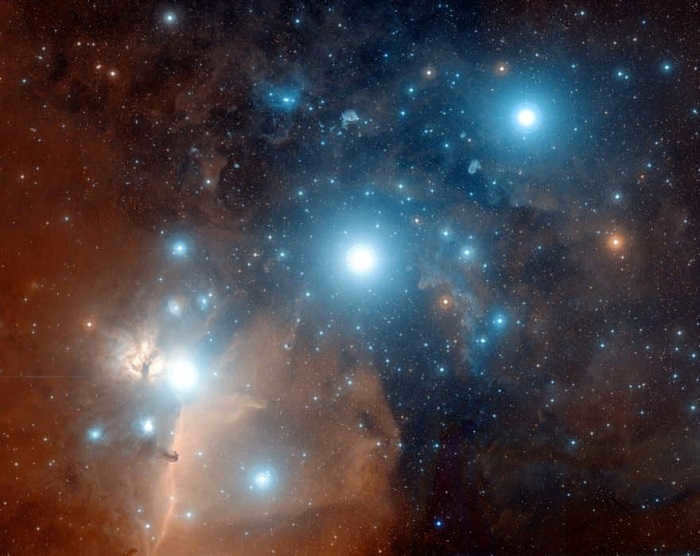
IC 434 is an emission nebula situated close to Alnitak, which is the star on the eastern side of Orion’s Belt in the night sky.
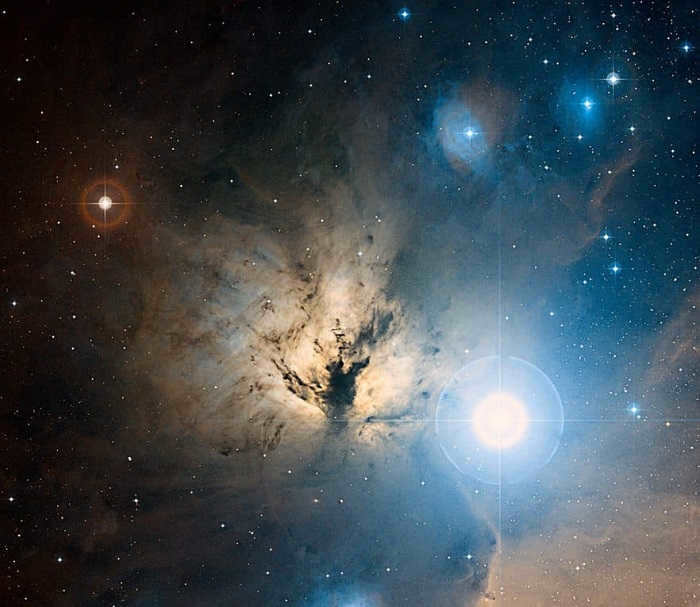
Saif is a blue supergiant star located in the southeastern region of the Orion constellation. It has a visual magnitude of 2.06 and is located about 720 light-years away from Earth. Saif is the sixth brightest star in the constellation and is part of the Orion quadrangle.
The star gets its name, Saif al jabbar, from the Arabic phrase meaning “sword of the giant.” Just like other bright stars in Orion, Saif is expected to end its life in a supernova explosion.
Nair Al Saif, also known as Orion’s Iota, is the fourth star system in the constellation and is the brightest star in Orion’s sword. It has an apparent magnitude of 2.77 and is located approximately 1,300 light-years away. The name Na’ir al Saif translates to “bright sword” in Arabic.
The primary focus is on a massive double star system that exhibits spectroscopic characteristics and has an orbital period of 29 days. The system consists of a blue giant star, classified as O9 III, and a companion star classified as B1 III. Due to the constant collision of stellar winds within this pair, it emits a significant amount of X-ray radiation.
Orion’s Lambda, on the other hand, is a blue giant star classified as O8III. It has a visual magnitude of 3.39 and is located at a distance of 1100 light years. This star also exists in a double star system, with a companion that is a hot blue-white dwarf classified as B0.5V. The apparent magnitude of the companion is 5.61, and it is positioned 4.4 angular seconds away from the host star.
The traditional name given to this celestial object is Meissa, which translates from Arabic as “shining”. It is occasionally referred to as Heka, meaning “white spot”.
Phi of Orion – refers to two star systems that are separated by 0.71 degrees. Phi-1 is a double star located 1000 light years away. The primary star is a main-sequence star (B0) with a visual magnitude of 4.39. Phi-2 is a giant star (K0) with a visual magnitude of 4.09 and is situated at a distance of 115 light-years.
Orion’s Pi is a collection of stars that form Orion’s shield, and they are relatively spread out compared to most binary and multiple star systems. Pi-1 and Pi-6 are separated by nearly 9 degrees.
Pi-1 (7 Orion) is the dimmest star in this system. It is a main-sequence white dwarf star (A0) with a visual magnitude of 4.60 and is located 120 light-years away.
Pi-2 (2 Orion) is a main-sequence dwarf star (A1Vn) with a visual magnitude of 4.35 and a distance of 194 light-years.
Pi-3 (1 Orion, Tabit) is a white dwarf (F6V) positioned 26.32 light-years away. It stands out as the brightest of the six stars. It has a mass of 1.2 times that of the Sun, a radius of 1.3 times that of the Sun, and is three times brighter. Scientists believe it may host planets the size of Earth. Al-Tabit, its Arabic name, means “patience.”
Pi-4 (3 Orion) is a double star that can be observed spectroscopically. It has an apparent magnitude of 3.69 and is located 1,250 light-years away. The star pair consists of a giant and a subgiant, both of spectral type B2. They are so close together that they cannot be visually separated, even with a telescope. However, their spectra reveal their binary nature. The stars orbit each other with a period of 9.5191 days. They have a mass that is 10 times that of the Sun and a luminosity that is 16200 and 10800 times greater.
Pi-5 (8 Orion) is a star with an apparent magnitude of 3.70 and a distance of 1,342 light-years.
Pi-6 (10 Orion) is a luminous orange giant (K2II). It is a variable star with an average visual magnitude of 4.45 and an estimated distance of 954 light-years.
This particular Orion is a binary star system characterized by blue stars (B0.5V) situated approximately 900 light-years away. It is known as Beta in the constellation of Lyra, and its brightness exhibits variability due to one object overlapping another. The visual magnitude of this system is 3.38.
Situated within the Orion Arm, a minor spiral arm of the Milky Way, it is positioned to the west of Orion’s Belt.
Orion’s Sigma is a multiple star system comprising of five stars located south of Alnitak. This system is estimated to be situated 1150 light-years away.
The primary focus lies on the double star Sigma Orion AB, consisting of two hydrogen-fusing dwarfs that are separated by a distance of 0.25 arc seconds. The brighter component is a blue star (O9V) with an apparent magnitude of 4.2. The companion star is a (B0.5V) star with an apparent magnitude of 5.1. It takes them 170 years to complete their orbital revolution.
Sigma C is classified as a dwarf star (A2V) with an apparent magnitude of 8.79.
Sigma D and E are also classified as dwarf stars (B2V) with magnitudes of 6.62 and 6.66 respectively. E is particularly notable for its high abundance of helium.
Tau Orion is a star (B5III) with an apparent magnitude of 3.59 and a distance of 555 light-years. It is visible to the naked eye without the need for technology.
Orion’s Xi is a G0V main-sequence dwarf with an apparent magnitude of 4.39 and a distance of 28 light-years. It is accompanied by a faint red dwarf with a rotation period of 14.1 years.
Gliese 208 is a K7 orange dwarf with an apparent magnitude of 8.9 and a distance of 37.1 light-years. It is believed to have been 5 light-years from the Sun 500,000 years ago.
Orion’s V380 is a triple star system that illuminates the reflected nebula NGC 1999. It has a spectral type of A0 and is located 1000 light-years away.
In the central region of the nebula, there is a conspicuous black spot that appears as a massive empty hole. The reason behind its darkness remains unknown, although there are theories suggesting that it could be a result of narrow streams of gas originating from nearby young stars that have penetrated the dust and gas layer of the nebula. Additionally, the presence of a more mature star in the vicinity emitting powerful radiation may have contributed to the formation of this hole.
The nebula is located 1,500 light-years away.
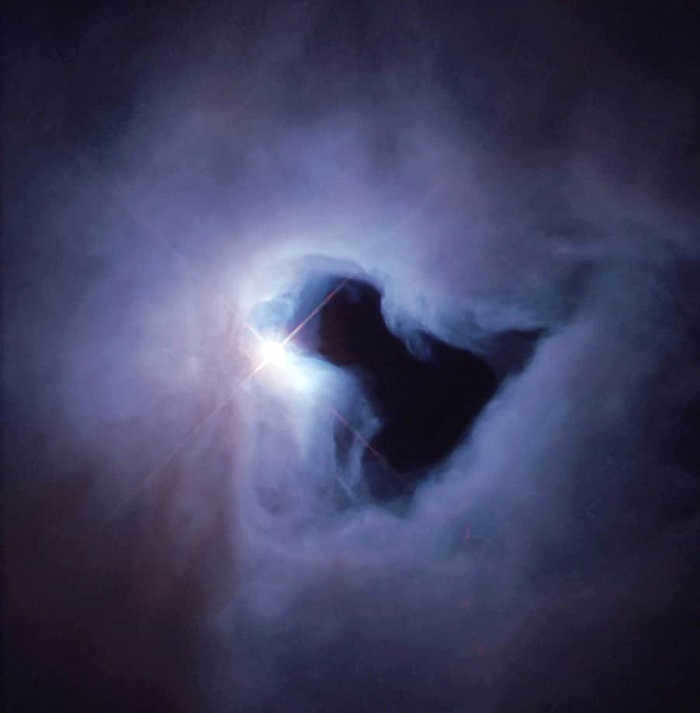
GJ 3379, an M3.5V red dwarf, possesses a visual magnitude of 11.33 and is situated 17.5 light-years away. There is evidence to suggest that it was positioned 4.3 light-years away from the Sun approximately 163,000 years ago. This star is the nearest to our solar system in the Orion constellation, and it is a mere 17.5 light-years away from us.
Astronomical Objects
The Orion Cloud encompasses a vast collection of dark clouds, luminous emission and reflection nebulae, obscure nebulae, H II regions (sites of active star formation), and young stars within the constellation. It resides approximately 1500-1600 light-years away and certain sections are observable to the naked eye.
The Orion Nebula (also known as Messier 42, M42, NGC 1976) is a diffuse reflection nebula situated to the south of the three stars that constitute Orion’s belt. It is alternatively referred to as the Great Nebula or the Great Orion Nebula.
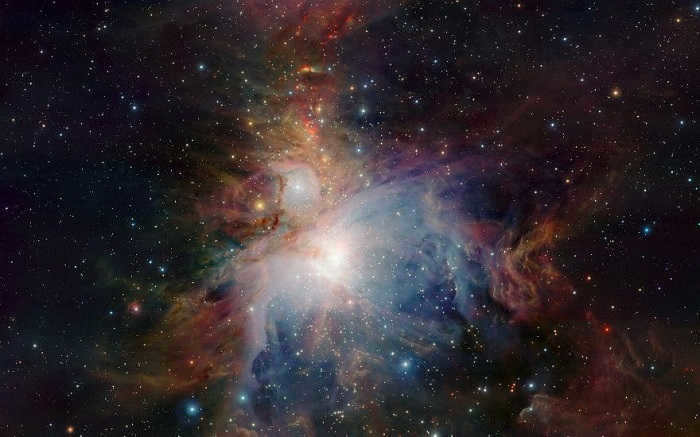
Having a visual brightness of 4.0 and situated 1,344 light-years away, it can be observed without the assistance of technology. It bears a resemblance to a worn-out star positioned to the south of Orion’s Belt.
It represents the closest area where massive stars are formed and is a constituent part of the Orion Cloud cluster. Orion’s Trapezium is a youthful open cluster. It can be easily identified by the presence of its four most brilliant stars.
The Trapezium cluster in the Orion Nebula is a youthful group of stars that can be seen with a visual magnitude of 4.0. It covers an area of 47 seconds of arc at the center of the nebula. Galileo Galilei first discovered this cluster on February 4, 1617, and he initially observed three stars (A, C, and D). Another star, known as the fourth member, was not identified until 1673. By 1888, the number of stars in the cluster had increased to eight. The five brightest stars in the Trapezium cluster are responsible for illuminating the surrounding nebula. This cluster is easily identifiable due to its distinctive arrangement of four stars, making it an asterism.
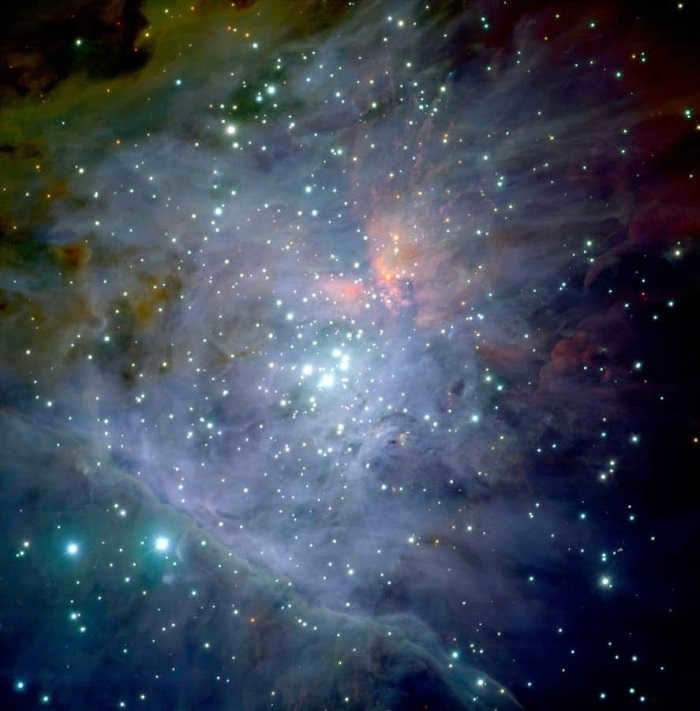
Theta-1 Orion C is the most brilliant and massive star in the constellation. It is categorized as a blue main-sequence star (O6pe V) and has a visual magnitude of 5.13. Located at a distance of 1500 light years, it is widely recognized as one of the most luminous stars, boasting an absolute magnitude of -3.2. Additionally, it holds the distinction of having the highest surface temperature among stars visible to the naked eye, measuring at 45,500 K.
The De Meran Nebula, also known as Messier 43 (M43) and NGC 1982, is an emission-reflection nebula where new stars are formed. Discovered by Jean-Jacques de Meran in 1731, it was later included in Charles Messier’s catalog.
Located 7 angular minutes north of Orion’s Trapezium, this celestial object is a part of the Orion Nebula, although it is separated from it by a wide band of interstellar dust. With an apparent magnitude of 9.0 and a distance of 1600 light years, it stands out in the night sky.
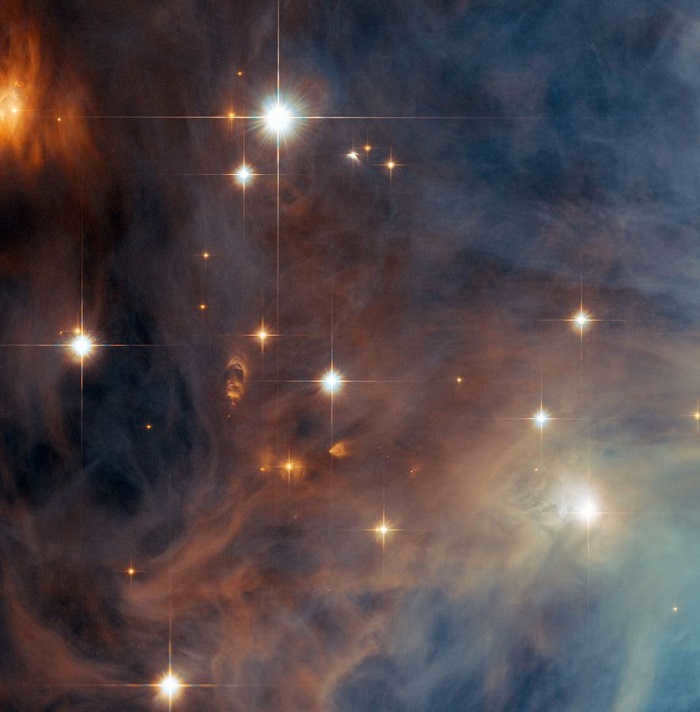
Messier 78 (M78, NGC 2068) is a reflection nebula located about 1600 light-years away with a visual magnitude of approximately 8.3. It was first observed by Pierre Mechene in 1780 and later included in Charles Messier’s catalog in the same year.
This nebula is notable for its association with two 10th magnitude stars and can be easily spotted using a small telescope. Additionally, it is home to around 45 T Taurus-type variables, which are young stars in the process of formation.
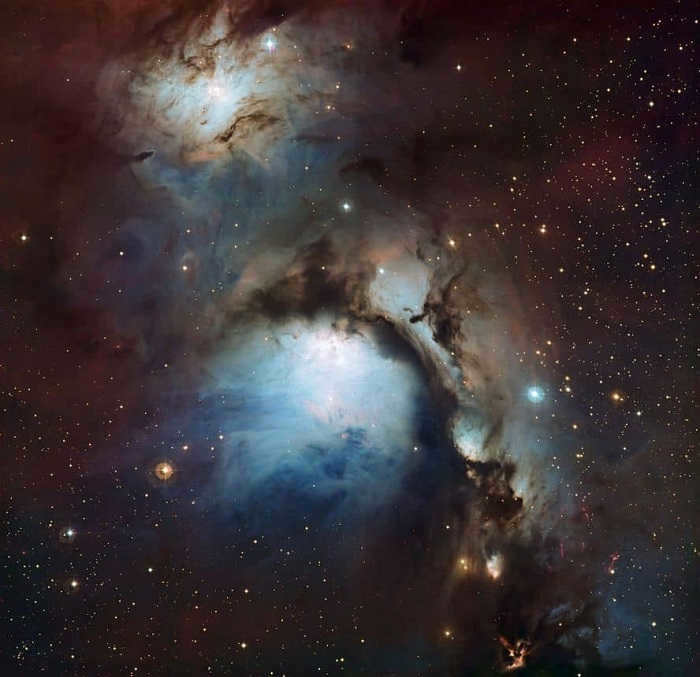
Astrologers have identified a dark nebula known as the Horsehead Nebula or Barnard 33. This celestial object can be found in the southern region of the Alnitak star and is connected to the luminous IC 434 emission nebula. The Horsehead Nebula is situated approximately 1,500 light-years away from Earth. Its existence was first recognized by the American astronomer William Fleming in the year 1888.
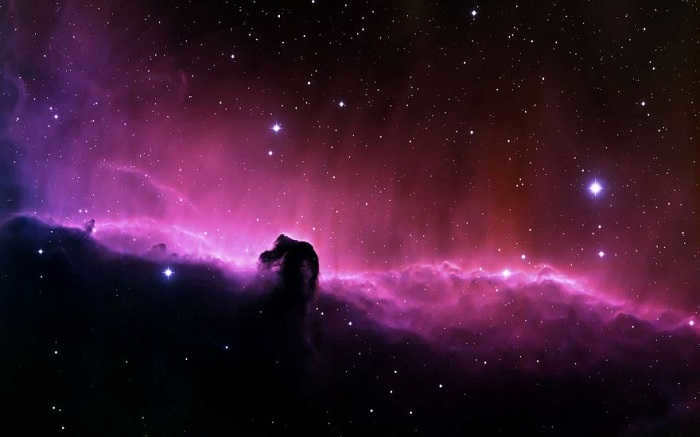
The constellation Orion got its name because of the distinct shape that is formed by dark, dusty clouds and gases, which resemble the head of a horse.
Barnard’s Loop is an emission nebula that is located within the molecular cloud complex of Orion. It is situated approximately 1600 light years away and has an apparent magnitude of 5. It is believed to have formed around 2 million years ago as a result of a supernova explosion. The loop spans a radius of 150 light years and covers a significant portion of the Orion constellation. It appears as a large arc centered around Messier 42. The loop is ionized by stars that are located in the Orion Nebula. This nebula was named in honor of E. E. Barnard, who captured an image of it in 1894 and provided a description.
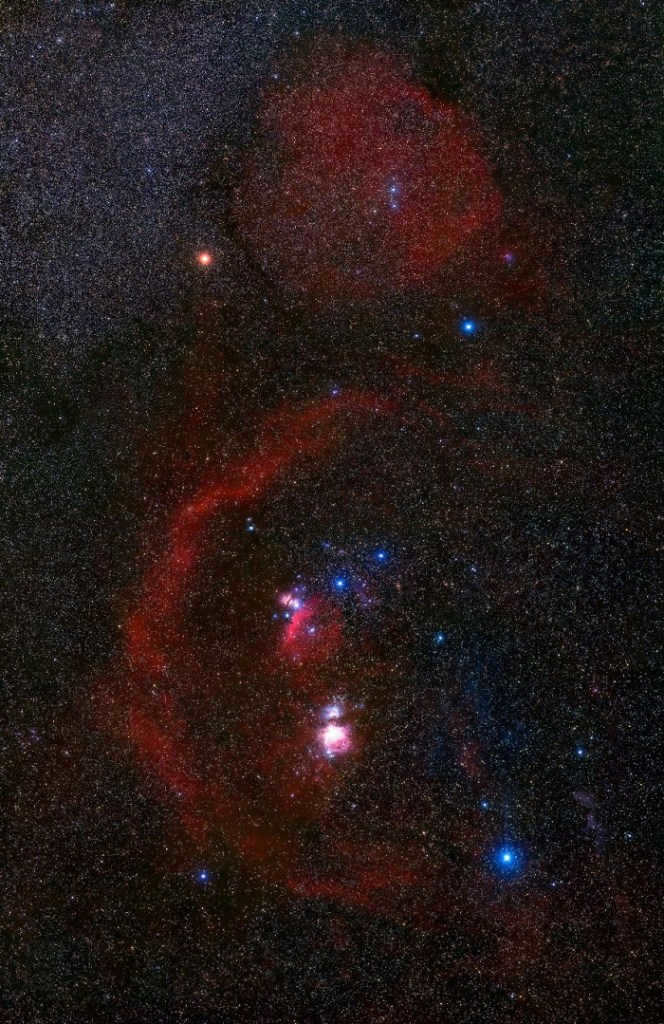
The Flame Nebula (NGC 2024) is a glowing cloud of gas and dust located approximately 900-1500 light-years away from Earth. It is illuminated by the brilliant blue supergiant star known as Alnitak. Alnitak emits powerful ultraviolet light that interacts with the hydrogen gas in the nebula, causing it to glow. This glowing effect is due to a process called recombination, where electrons and ionized hydrogen atoms come together.
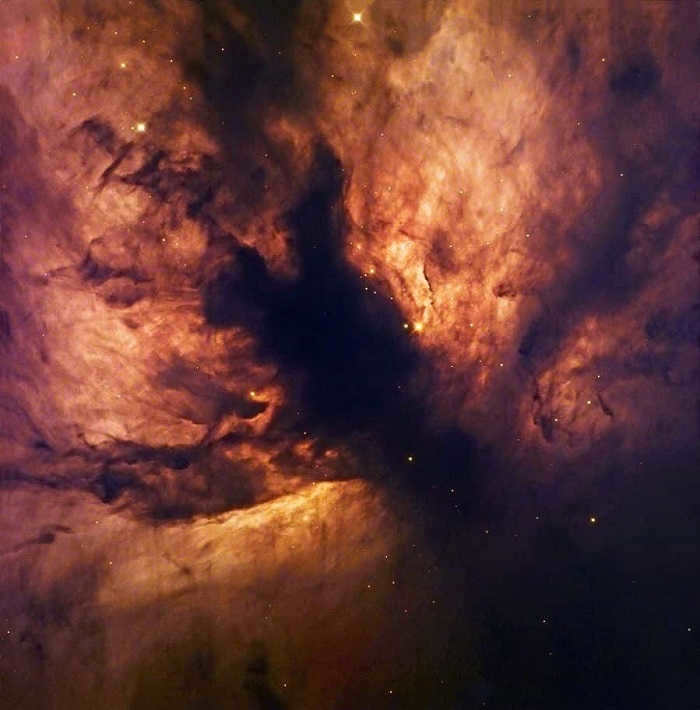
NGC 2169, also known as Cluster 37, is an open star cluster located approximately 3,600 light-years away. It has an apparent magnitude of 5.9 and is less than 7 arc minutes in diameter. The cluster is home to 30 stars, all of which are 8 million years old. The brightest star in NGC 2169 has an apparent magnitude of 6.94.
Giovanni Batista Godierna, an Italian astronomer, discovered NGC 2169 in the mid-17th century. It was independently observed by William Herschel on October 15, 1784. The cluster is sometimes referred to as “37” due to the arrangement of stars resembling this number.
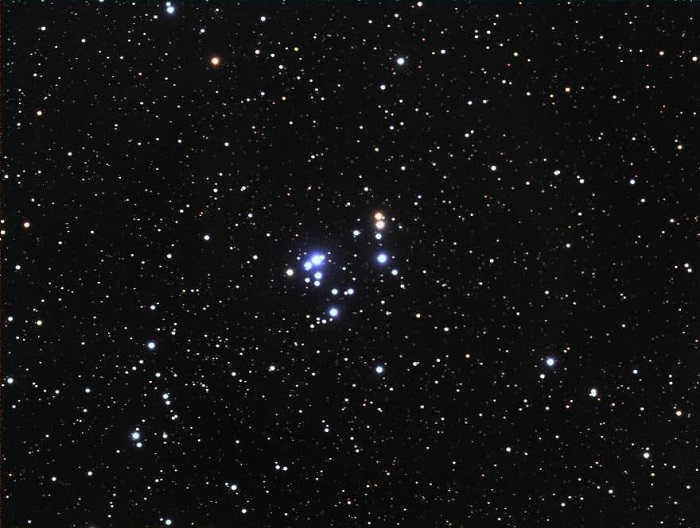
NGC 2023, an illuminated reflection nebula, is renowned as a highly luminous reservoir of fluorescent molecular hydrogen. Situated 3 degrees away from the Horsehead Nebula, it resides at a distance of 1467.7 light-years and is bathed in the radiance of the star HD 37903.
